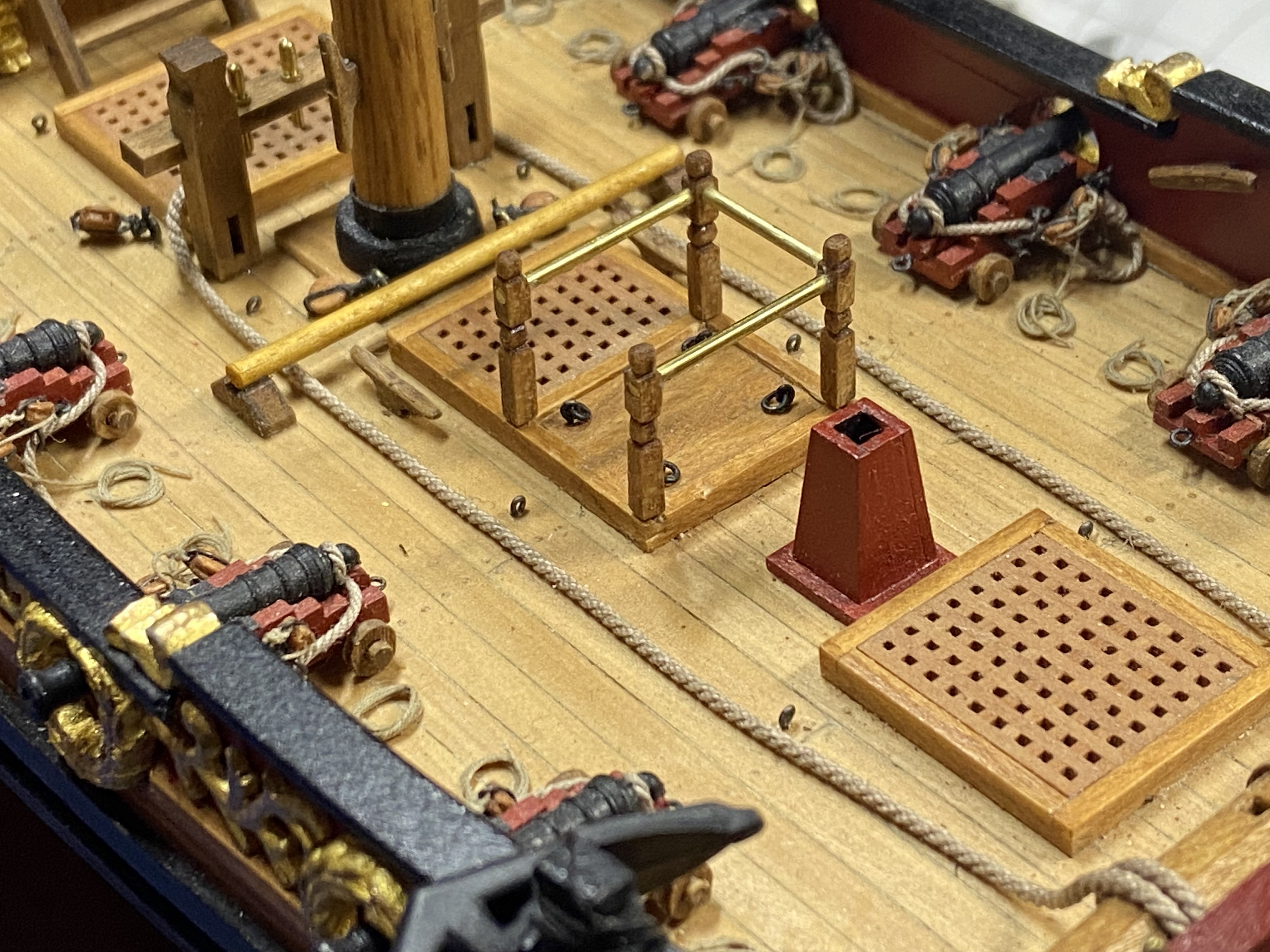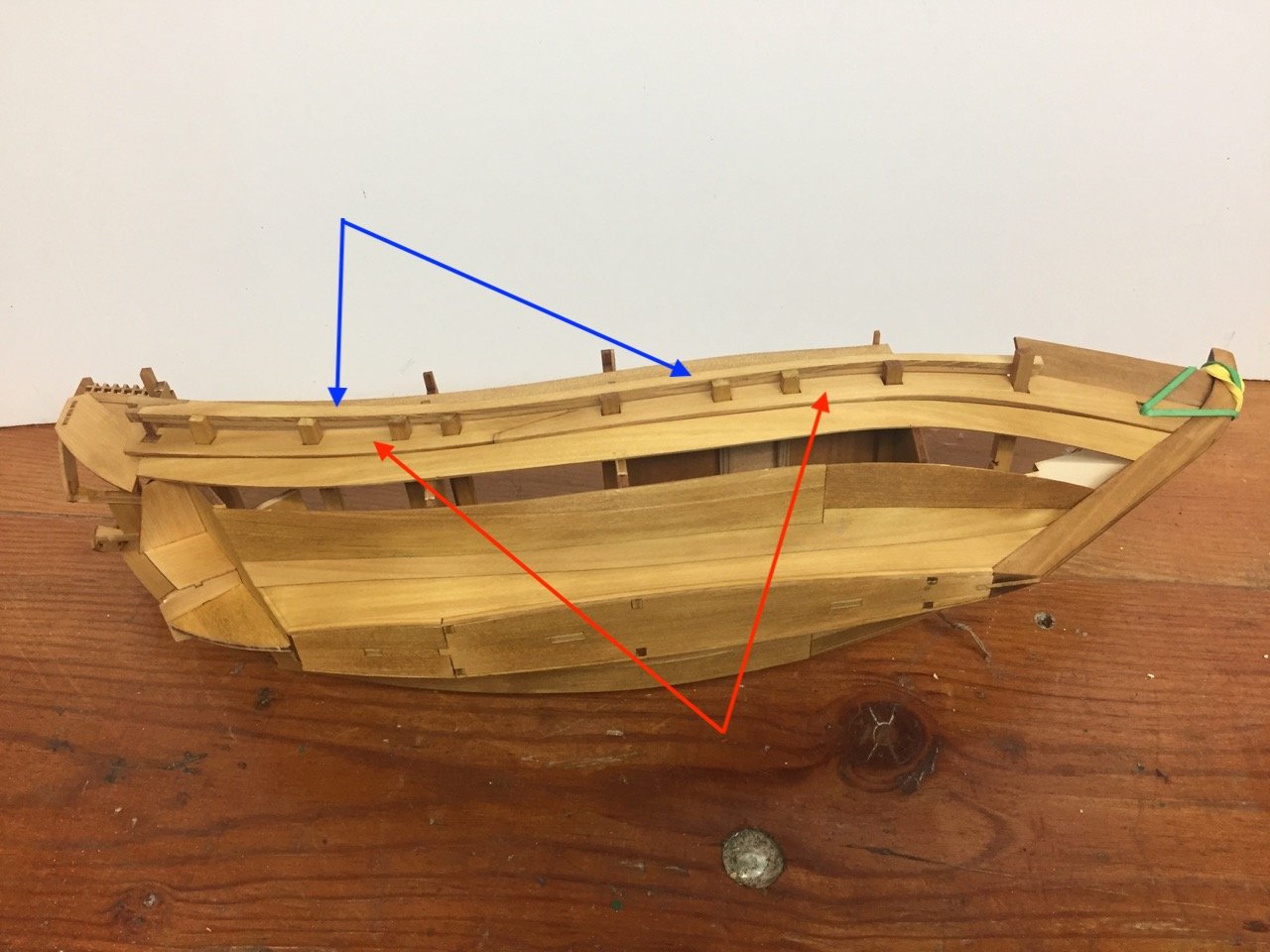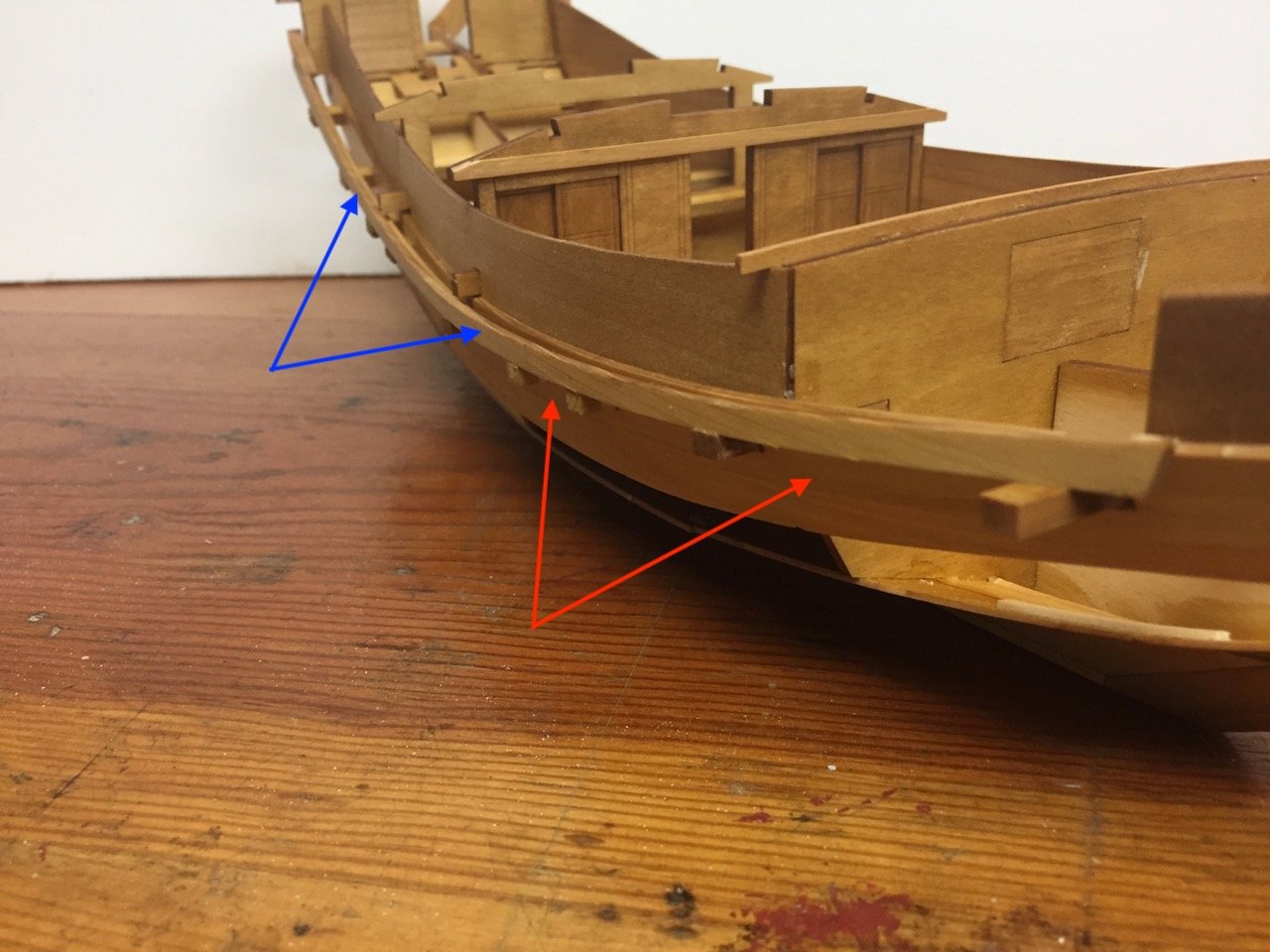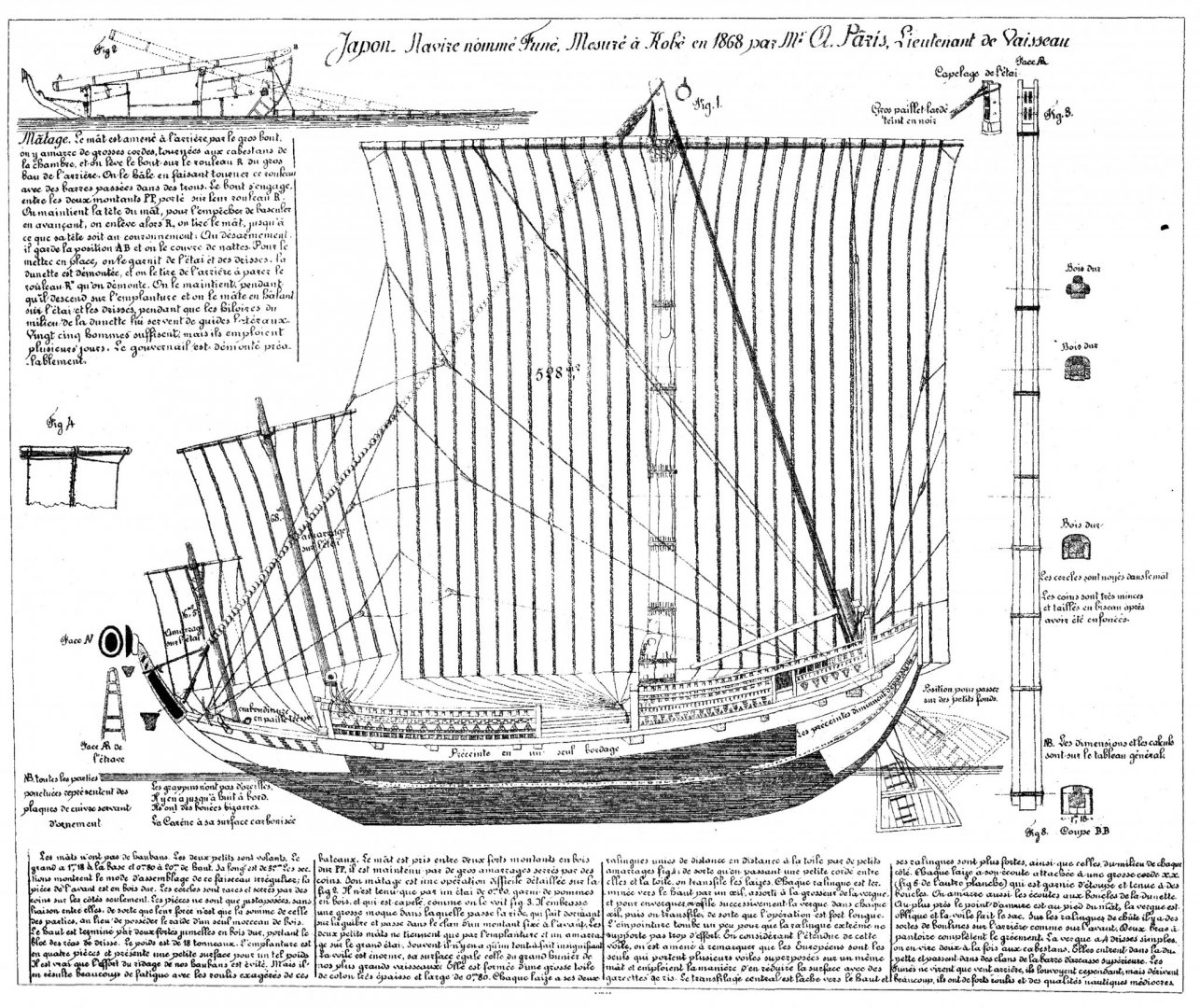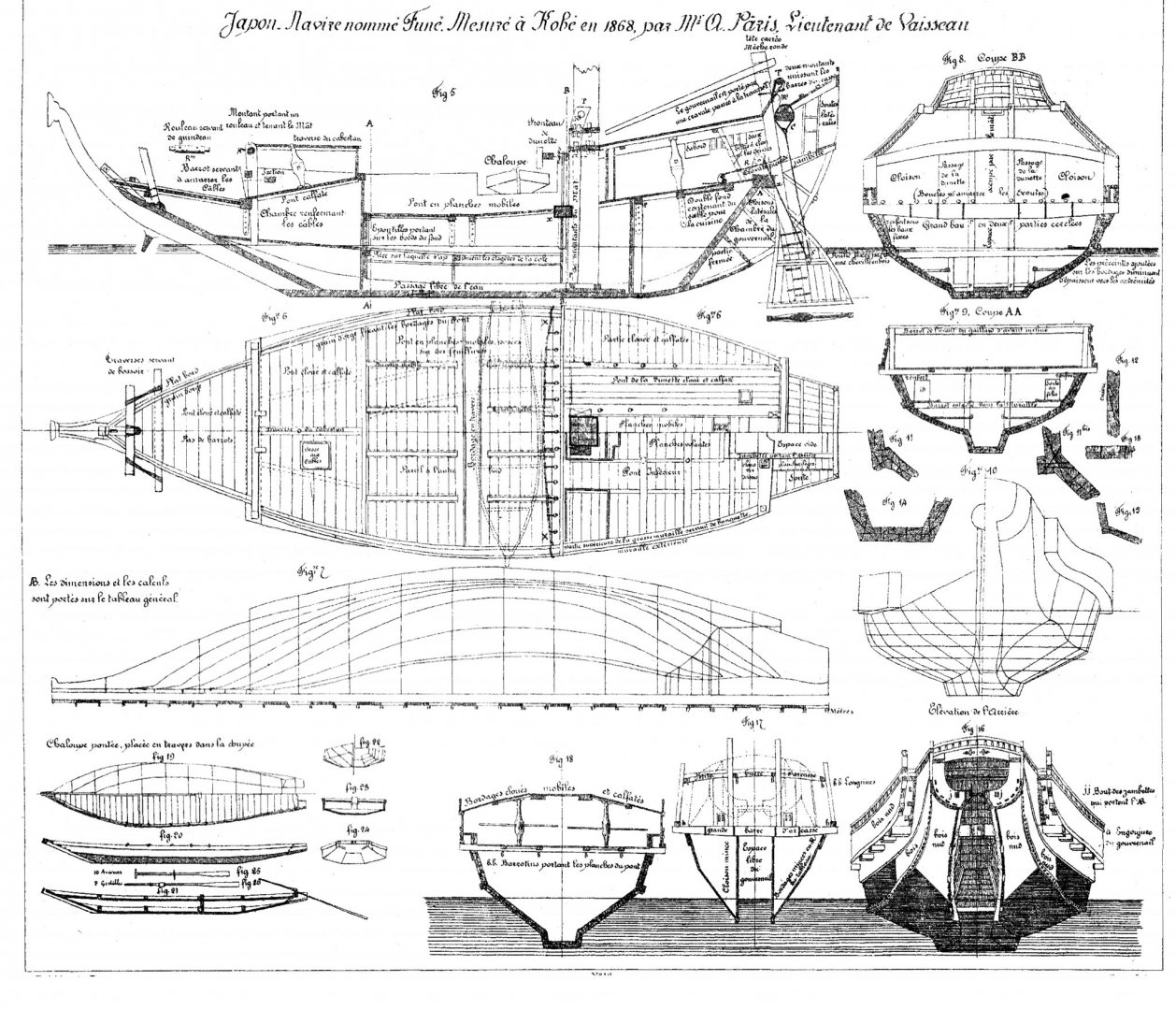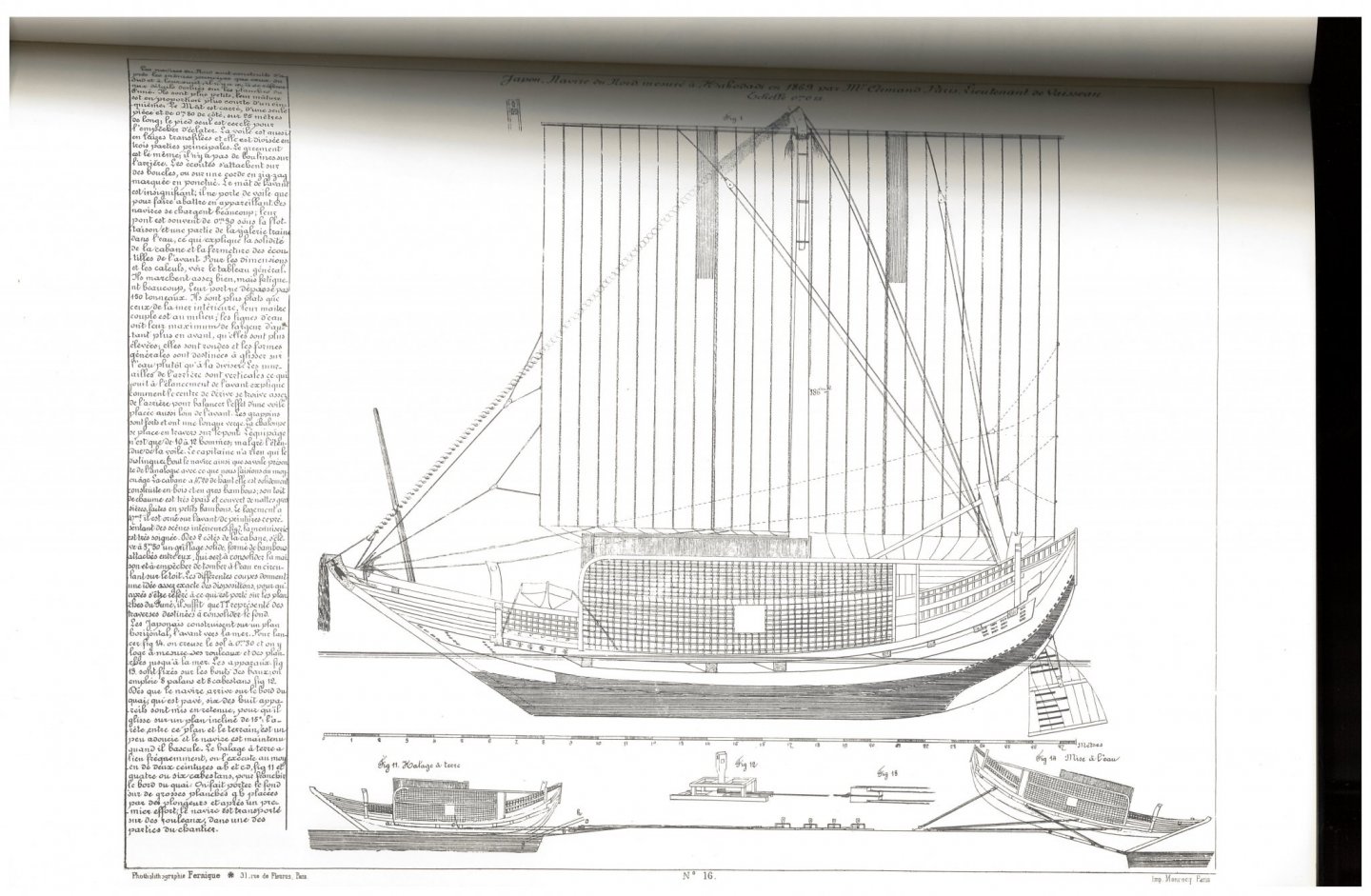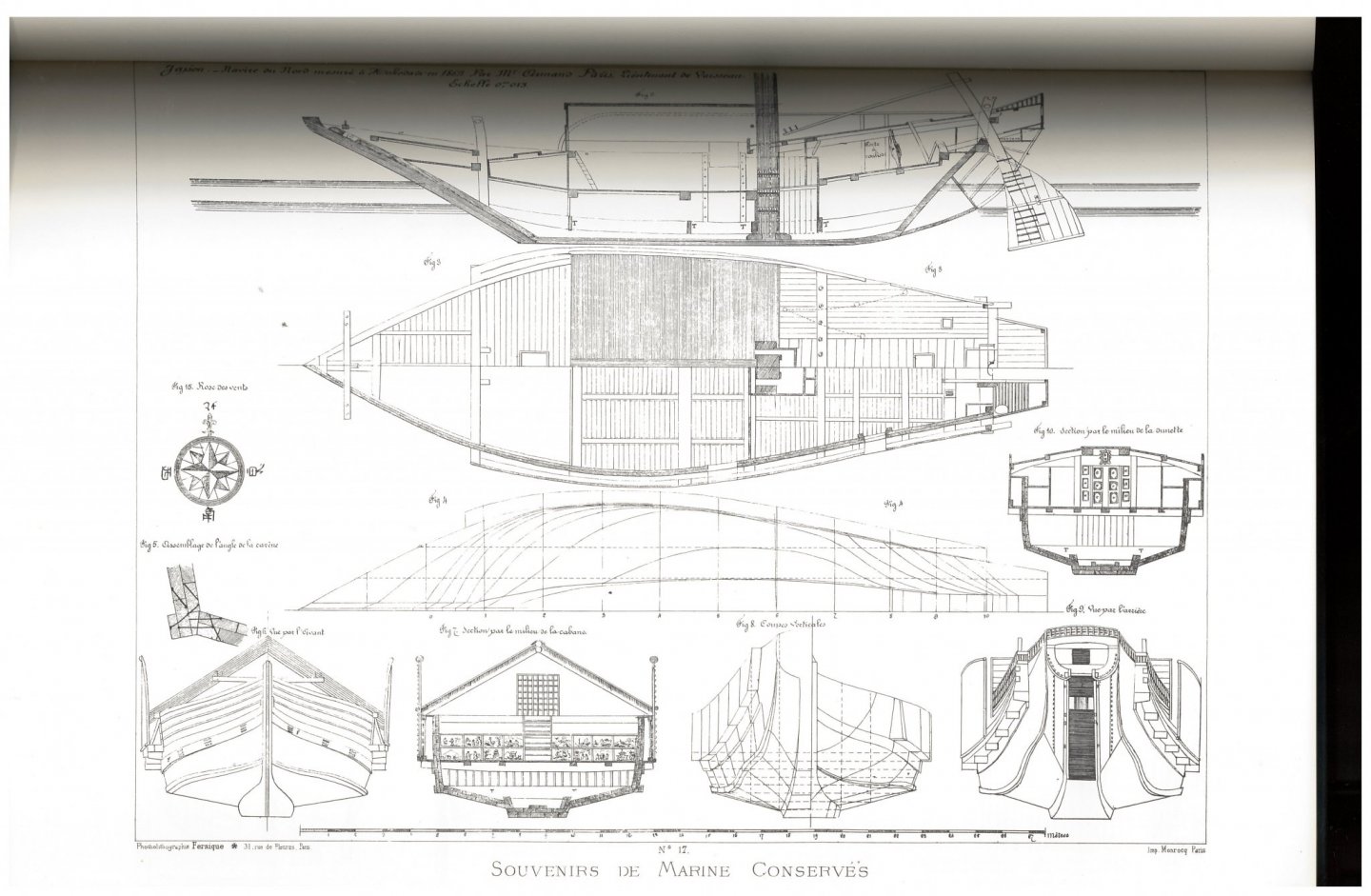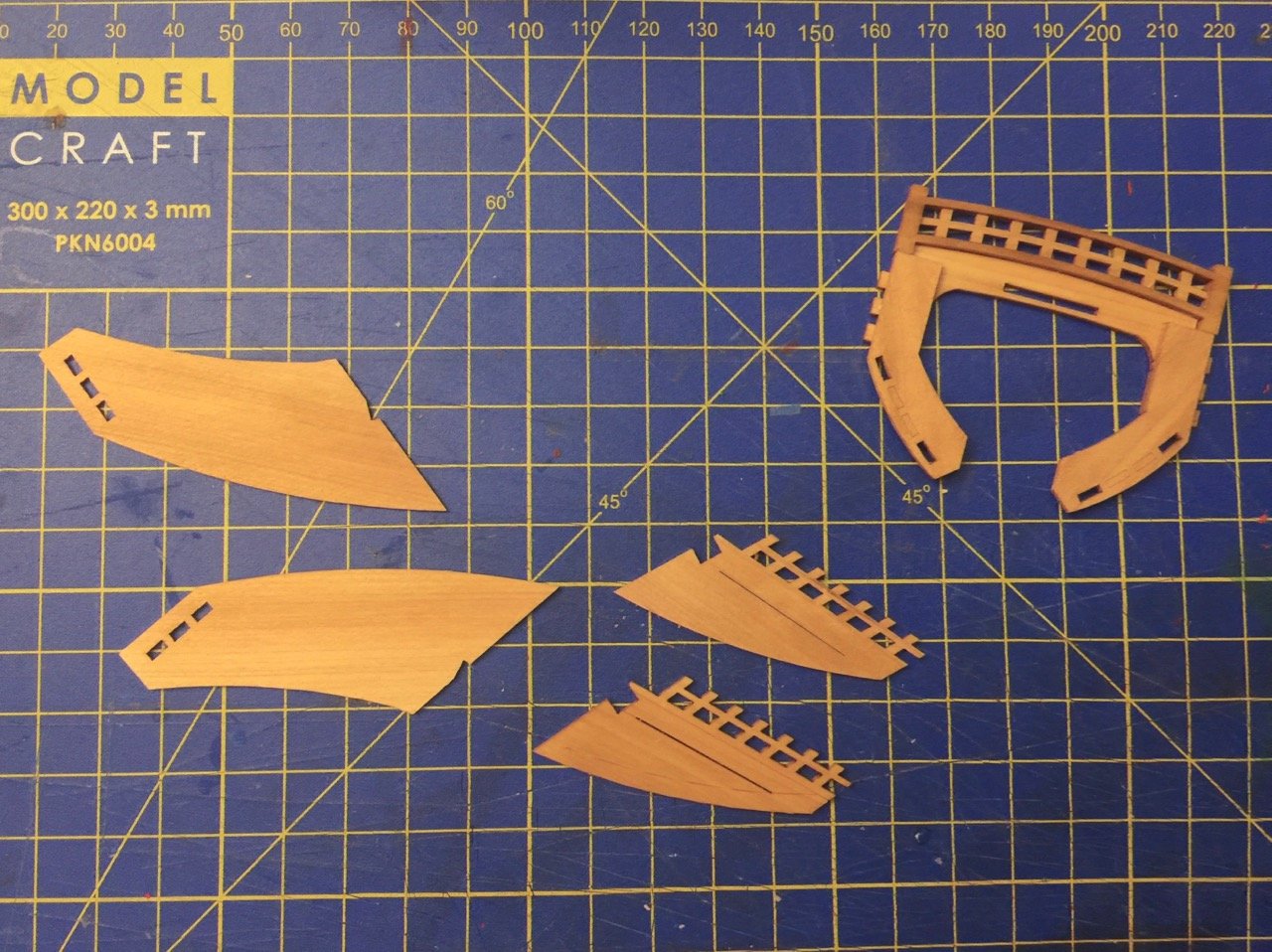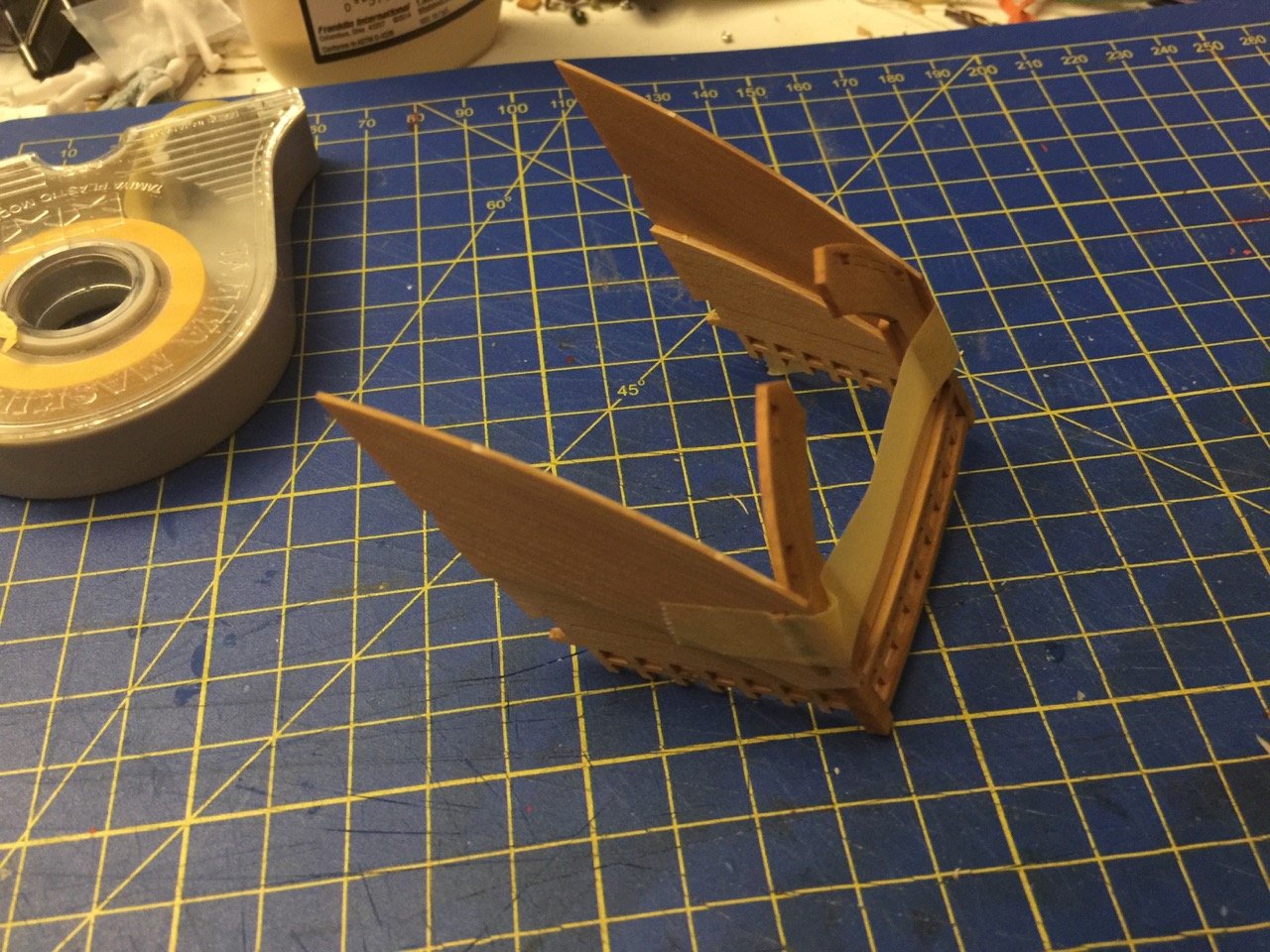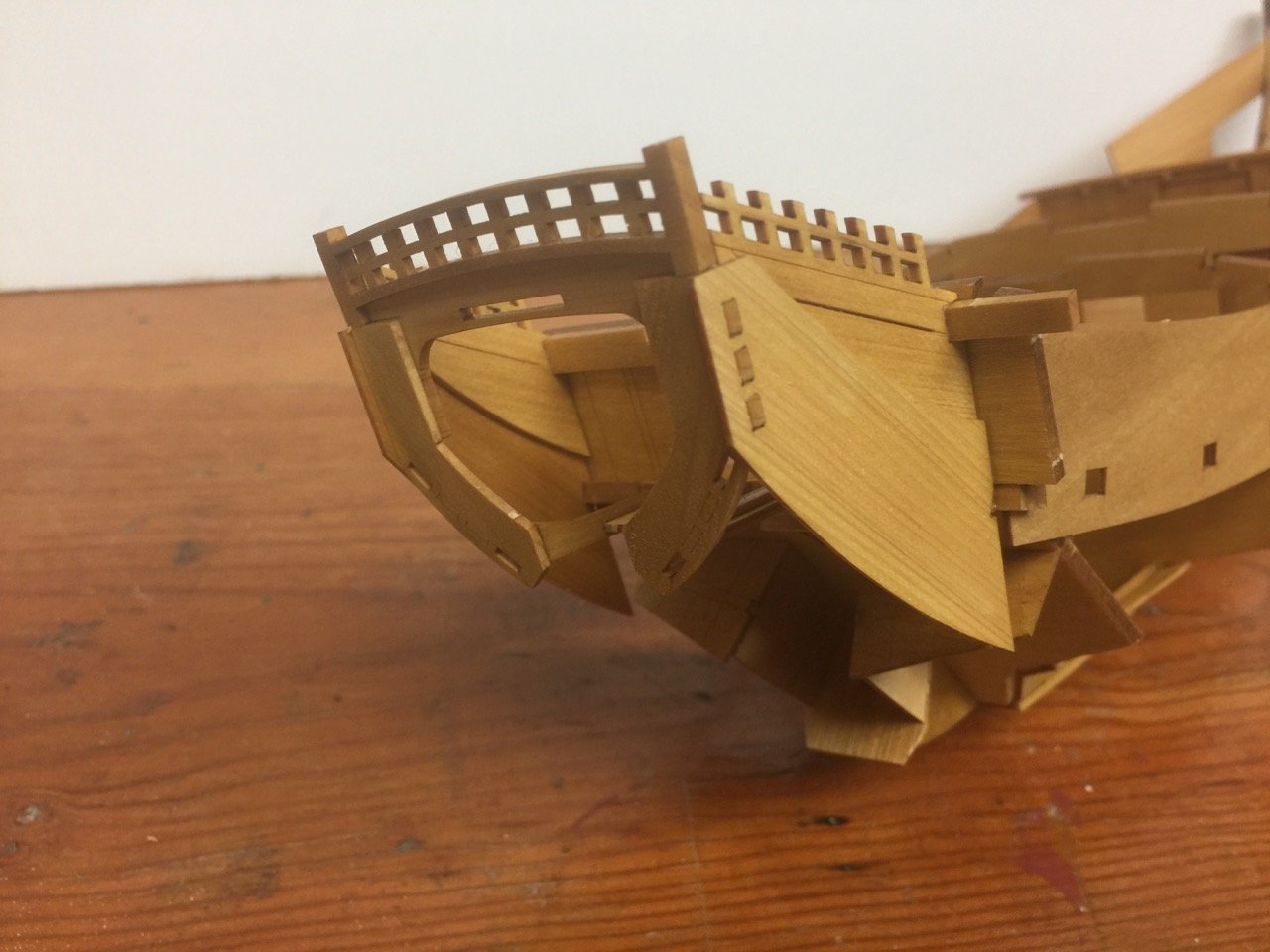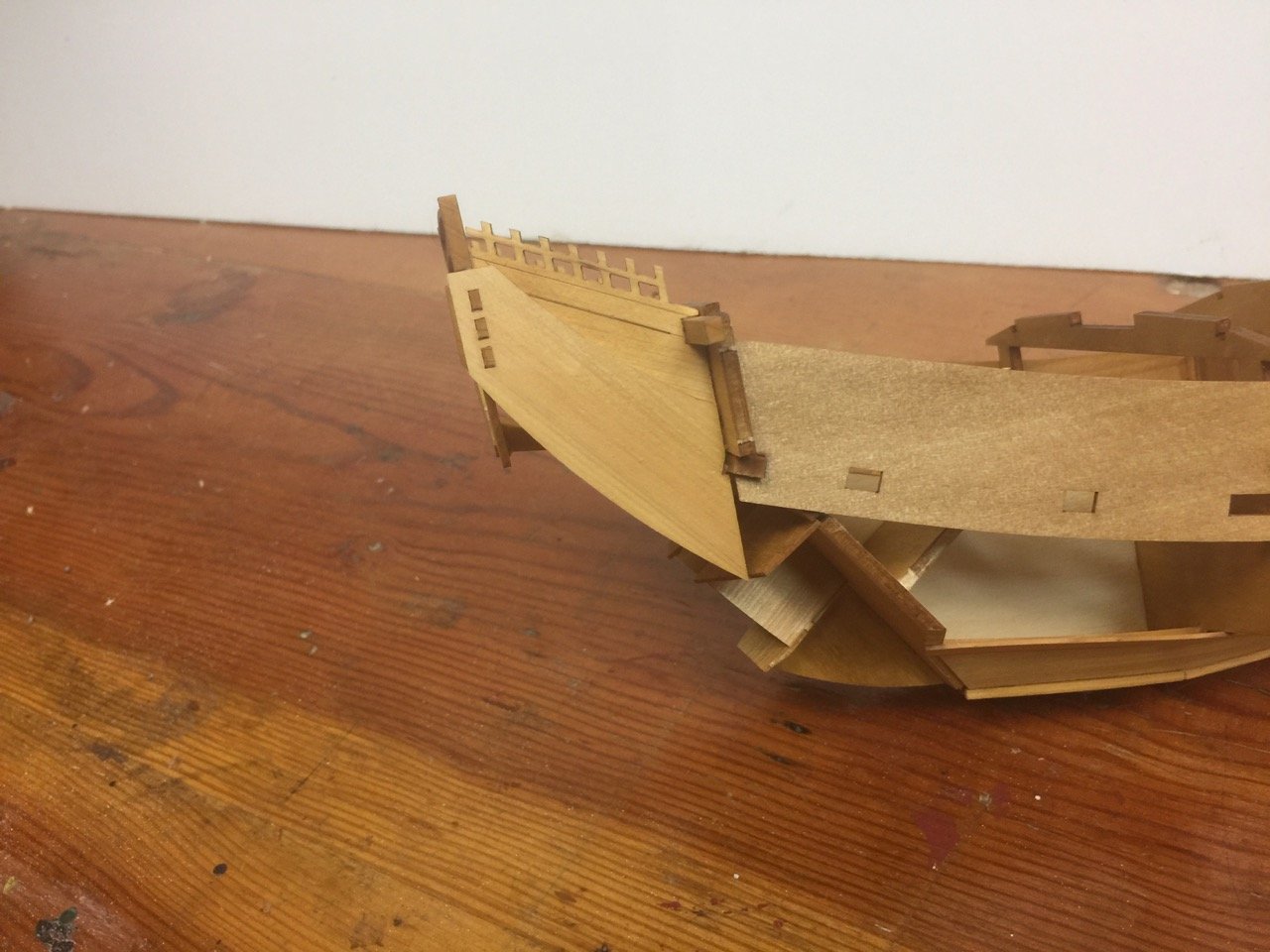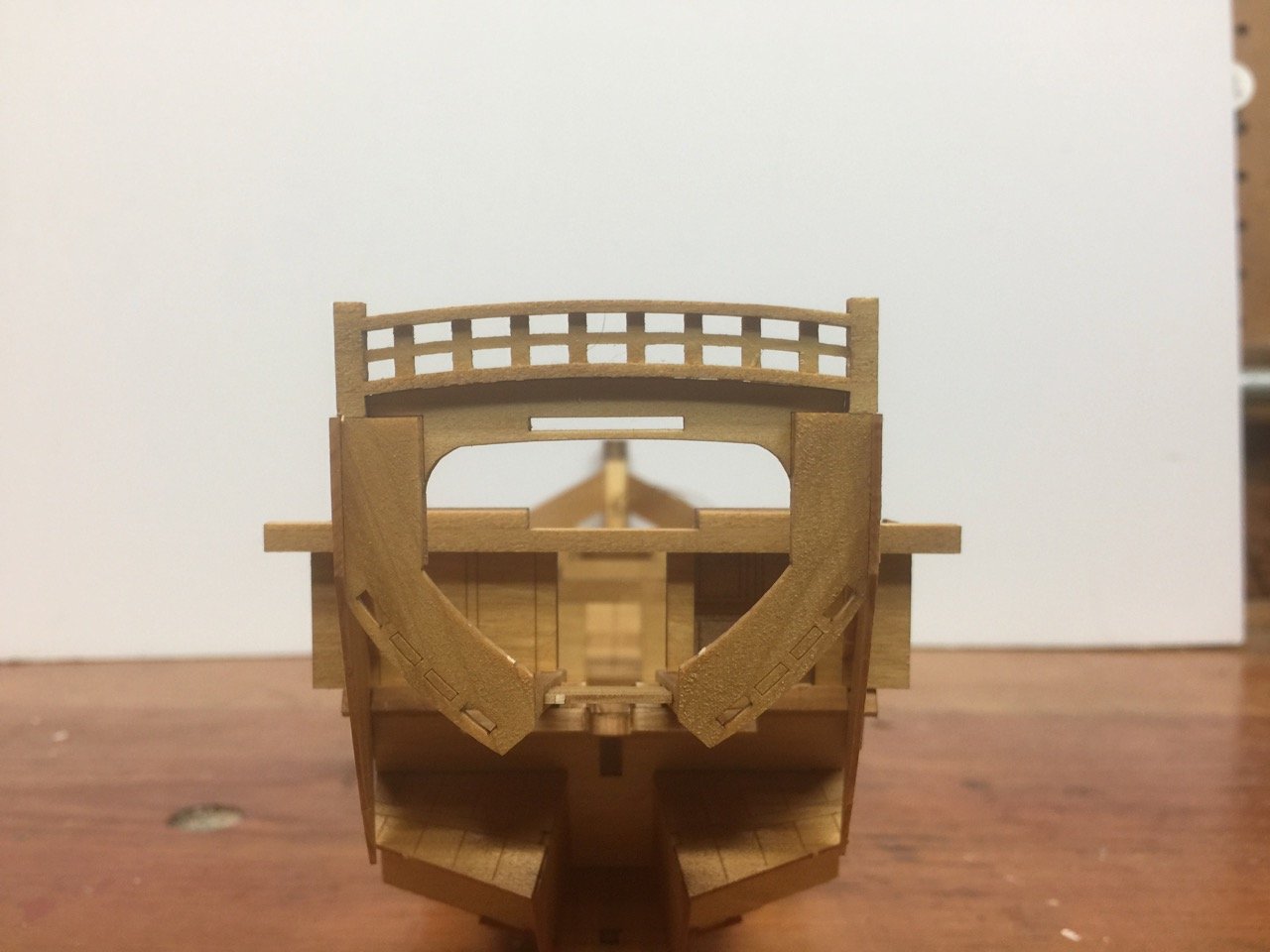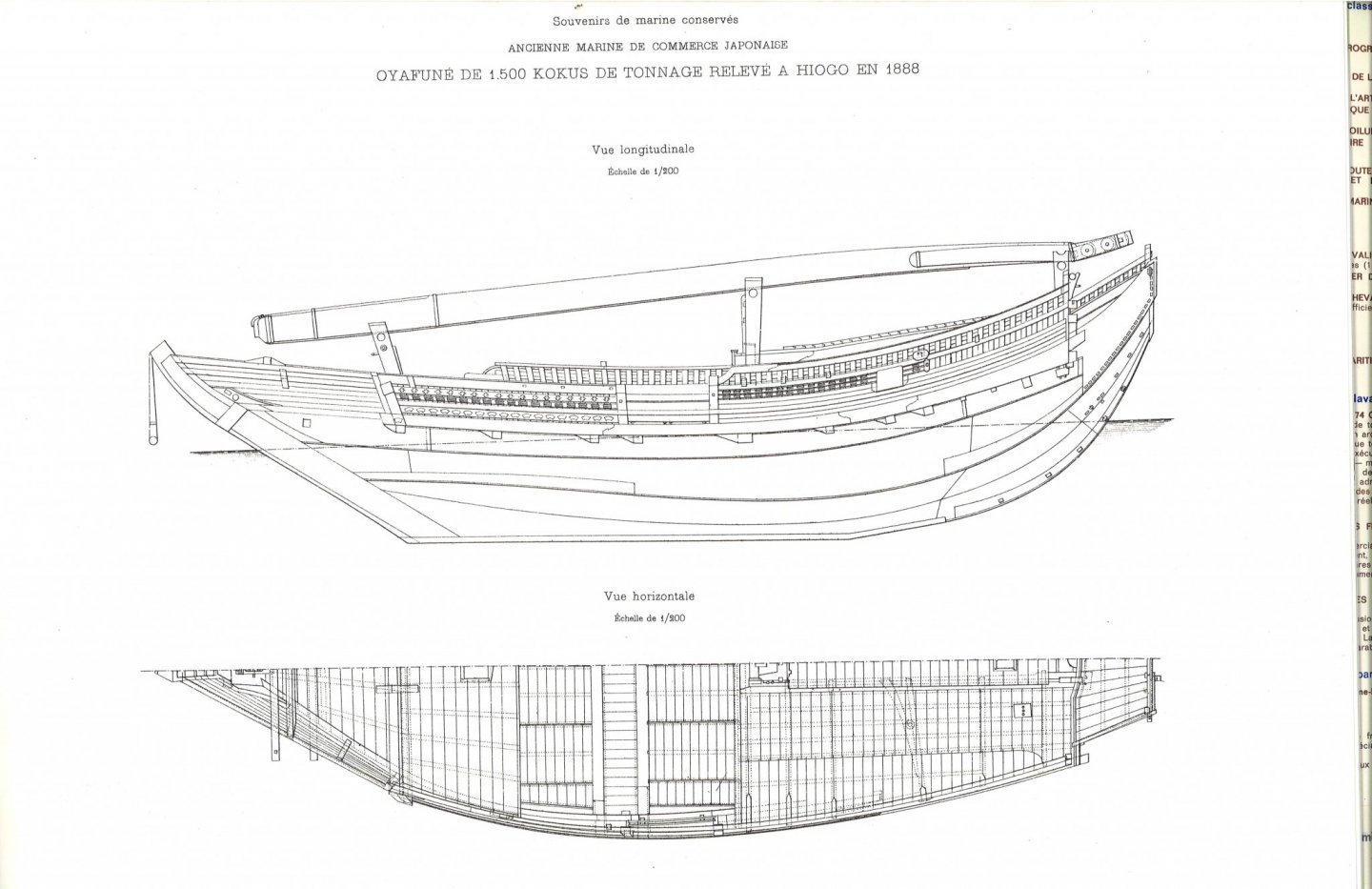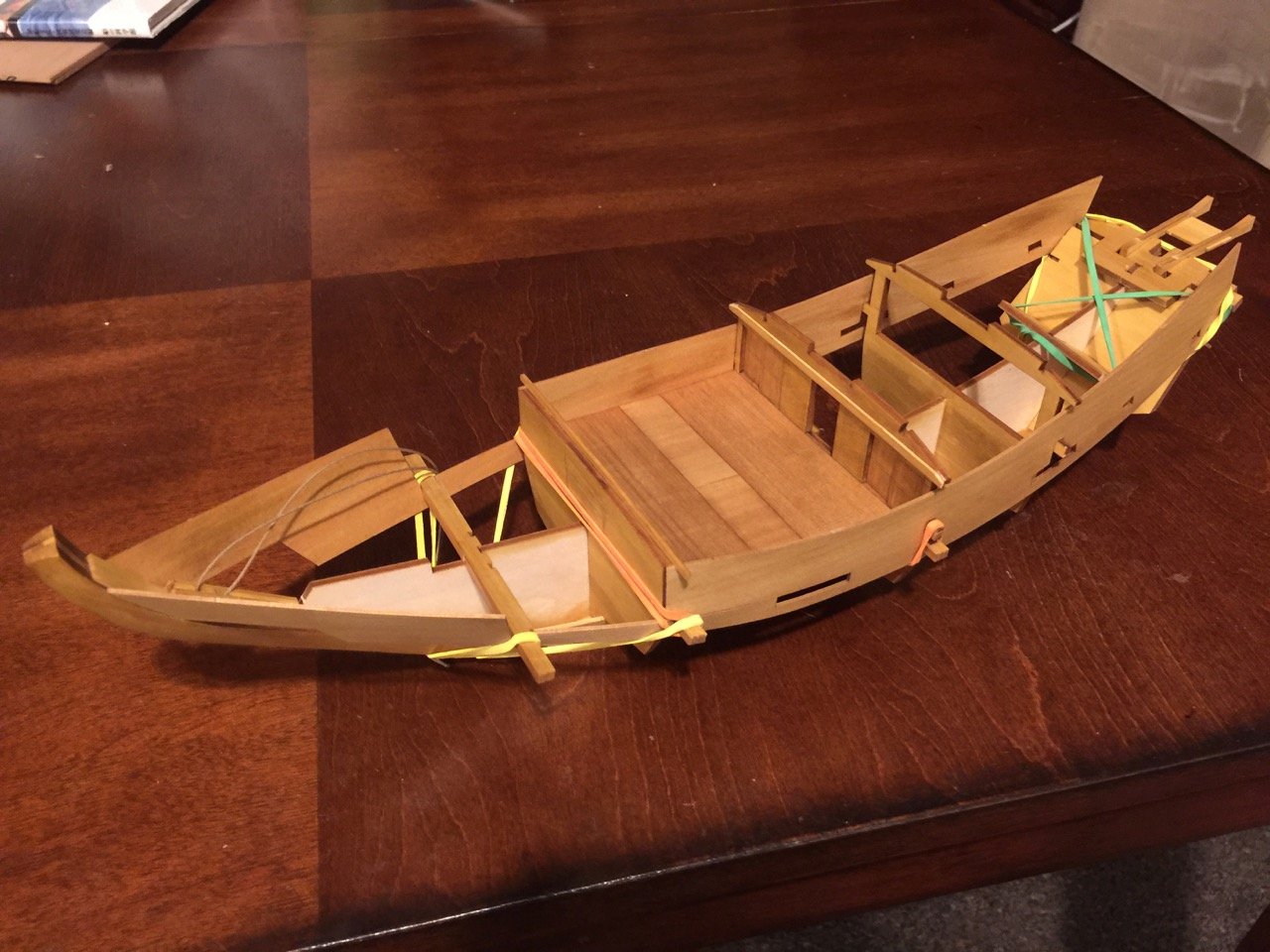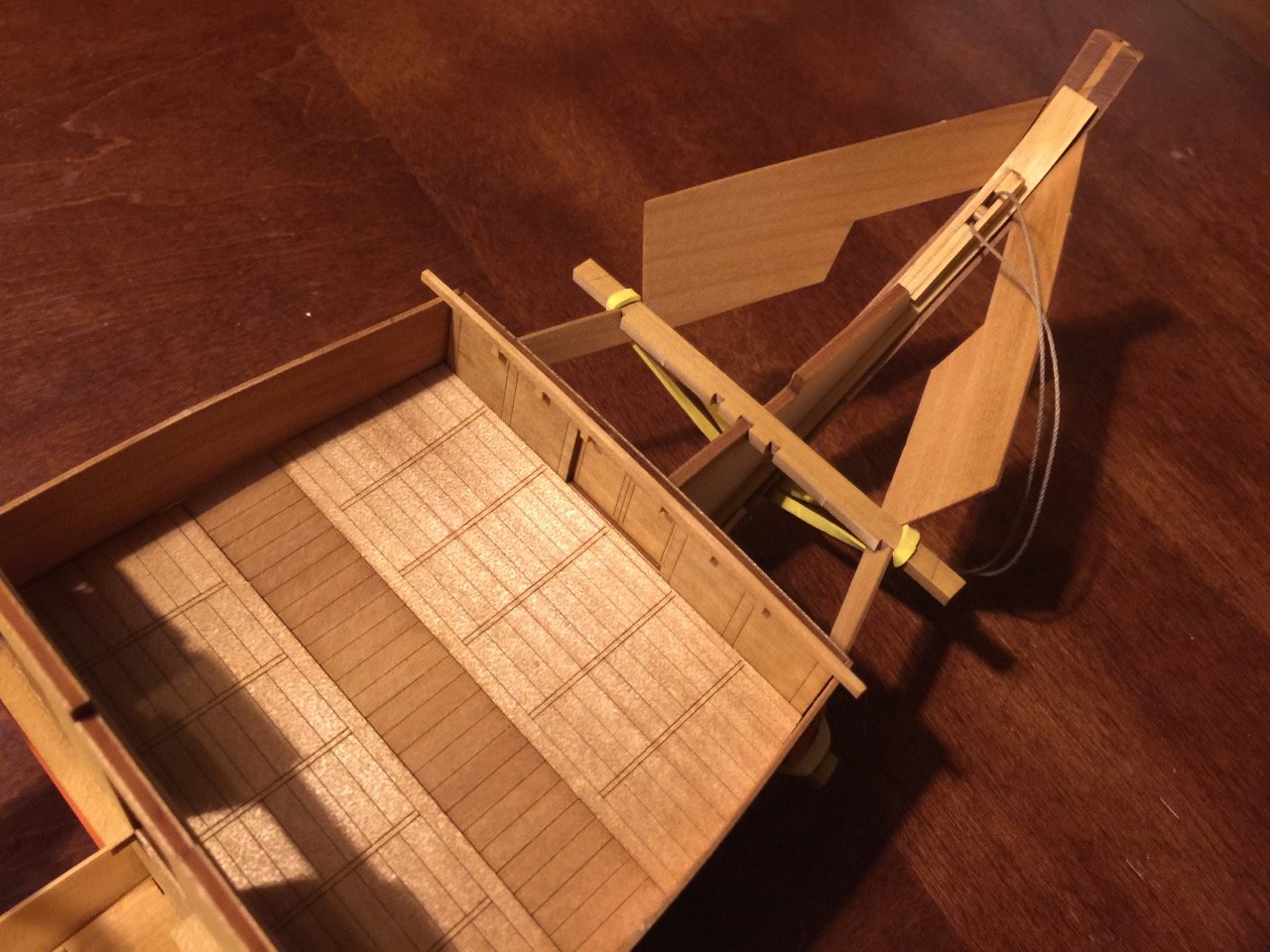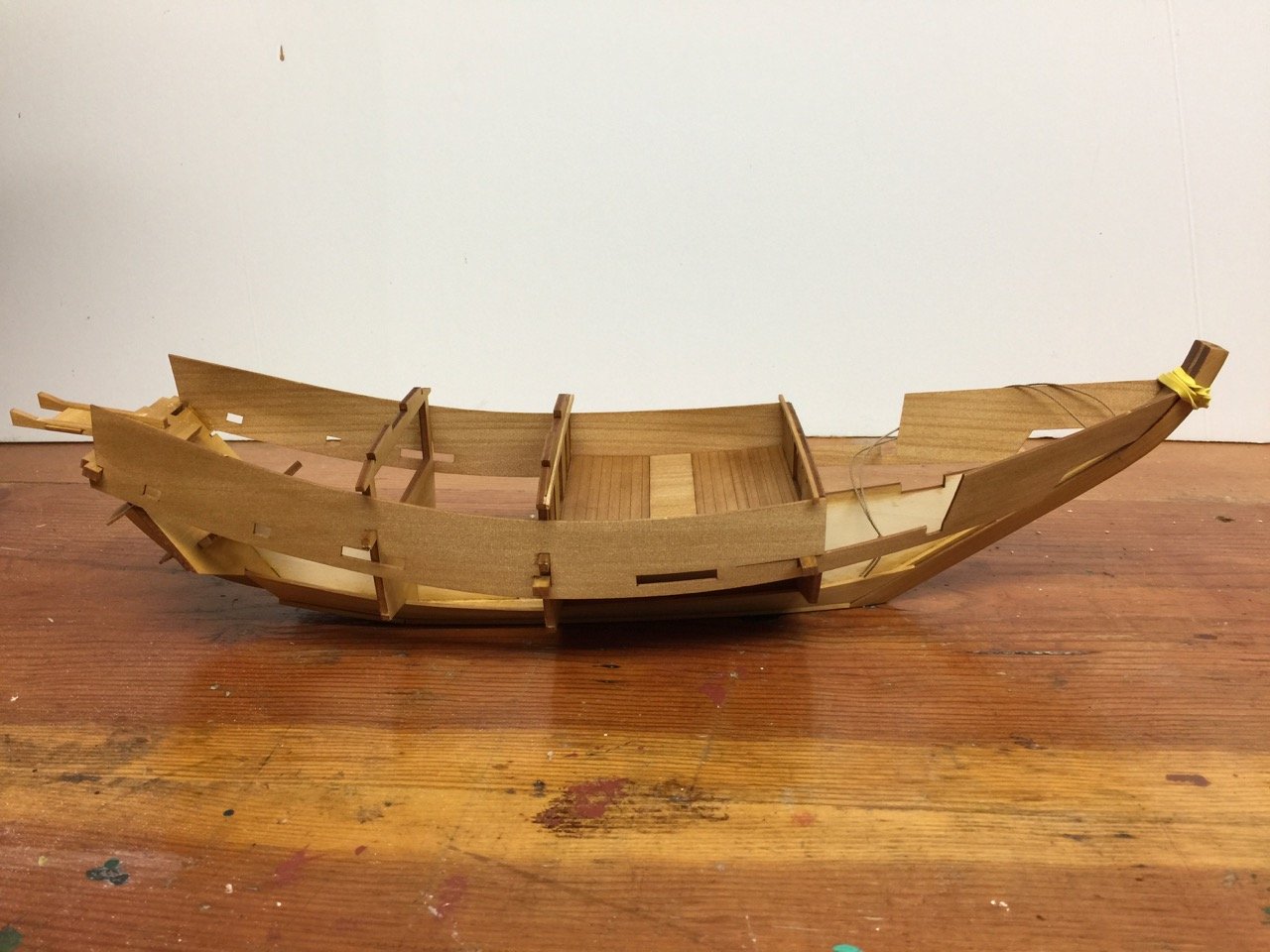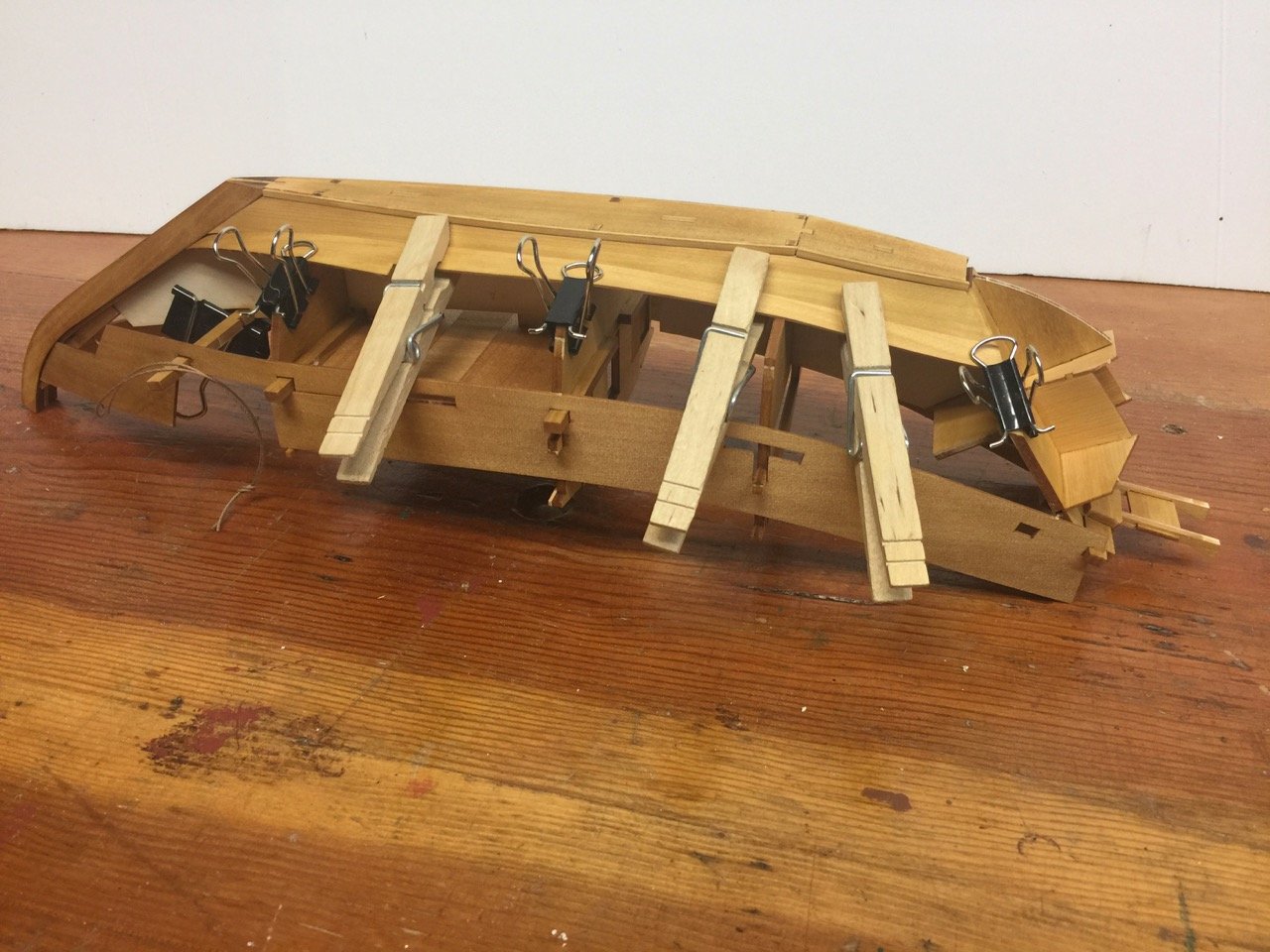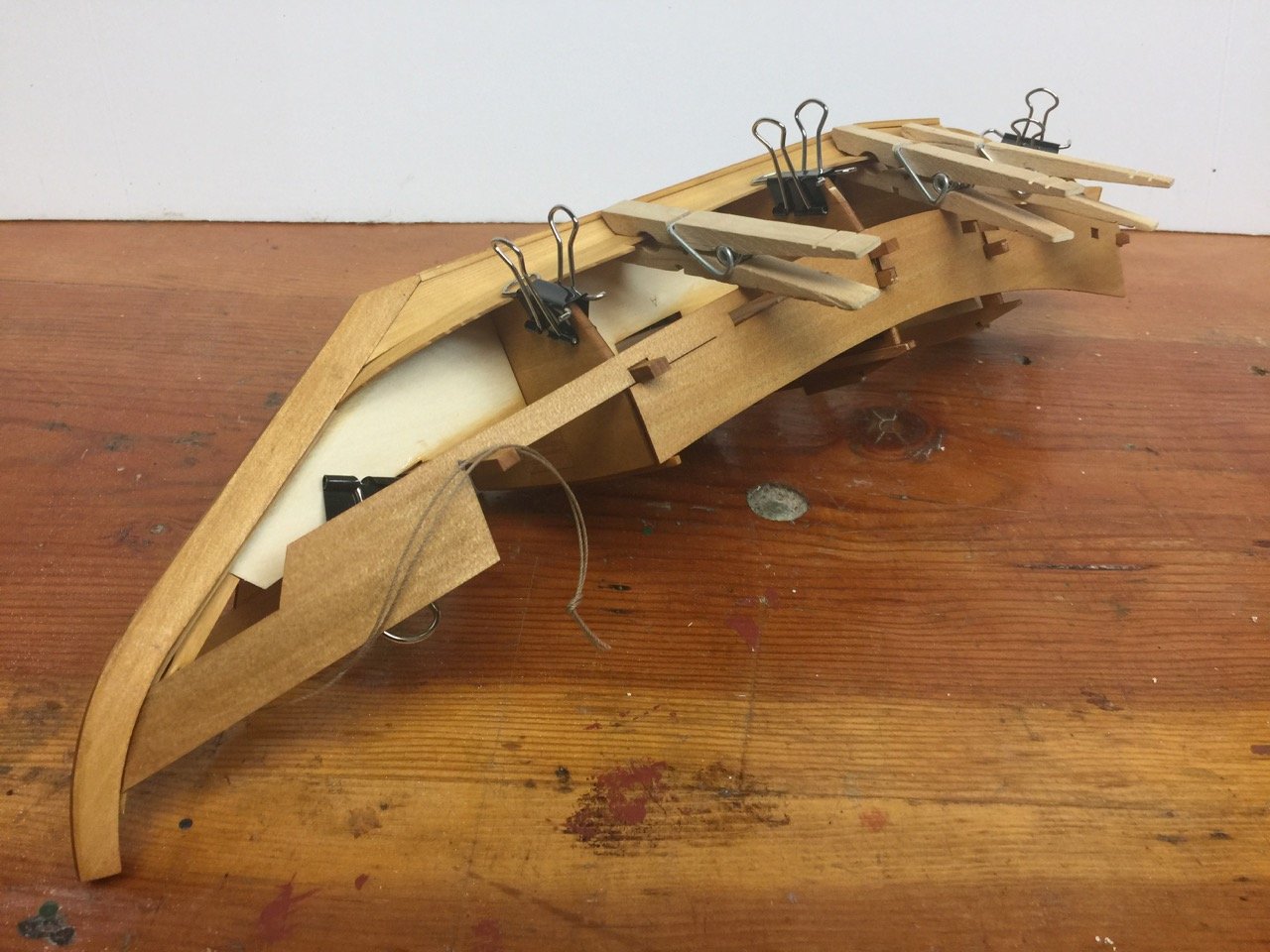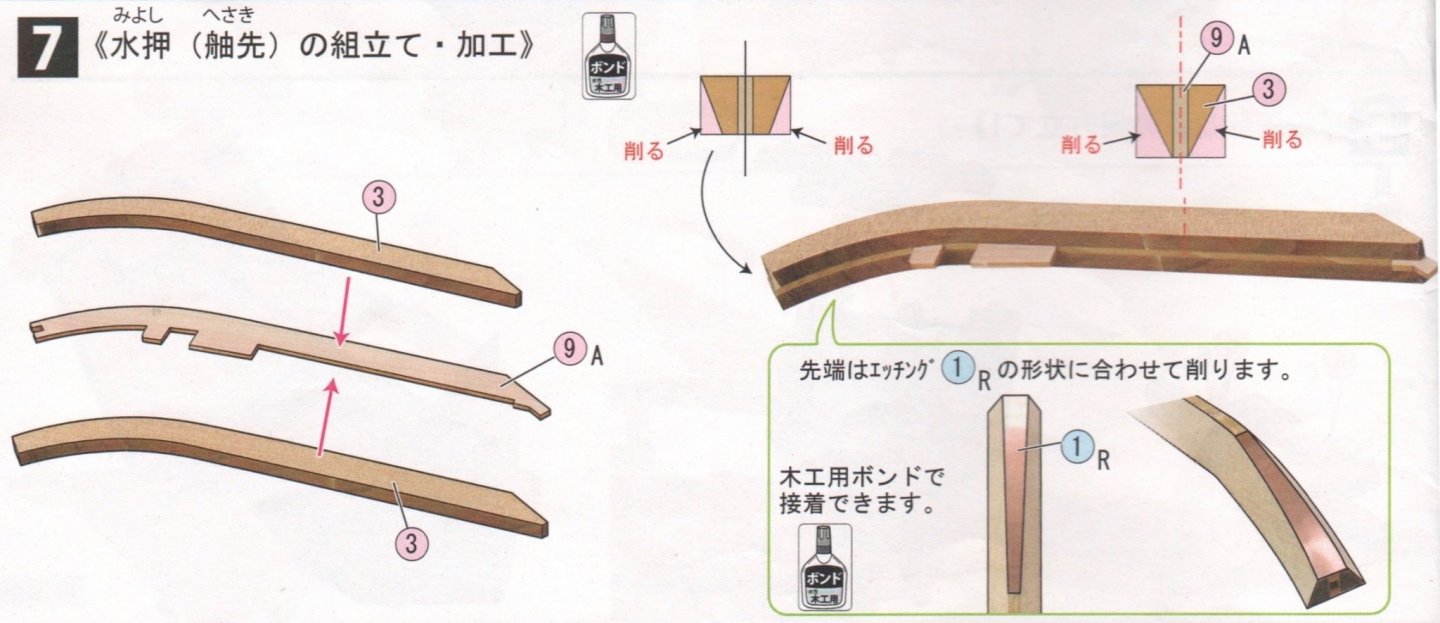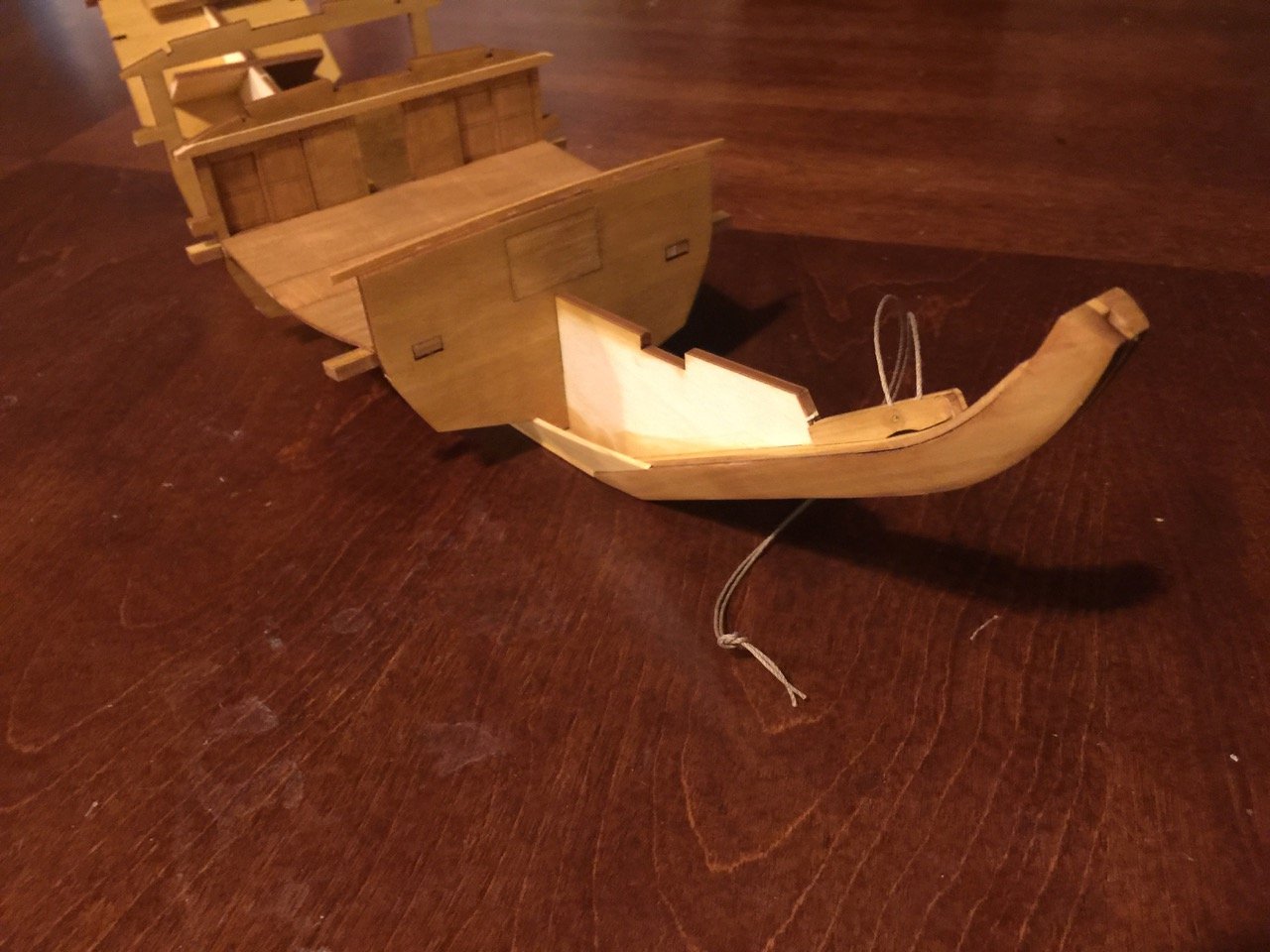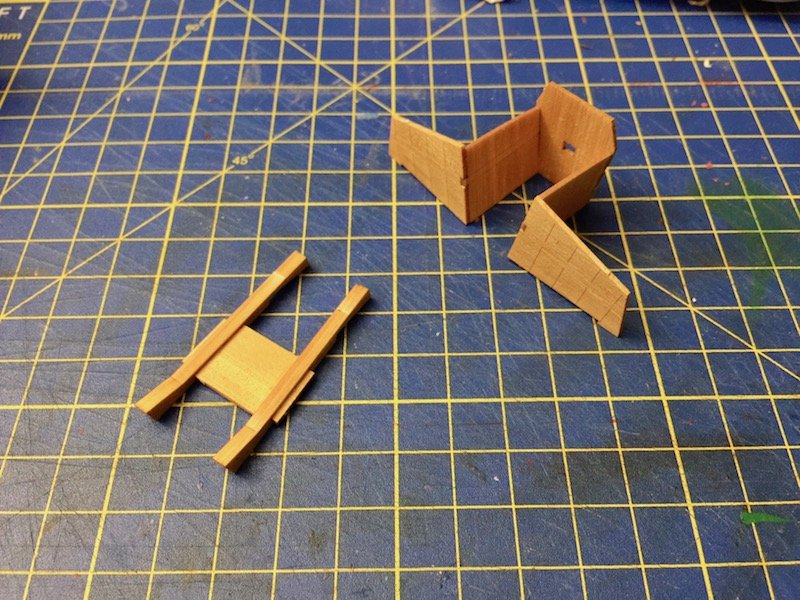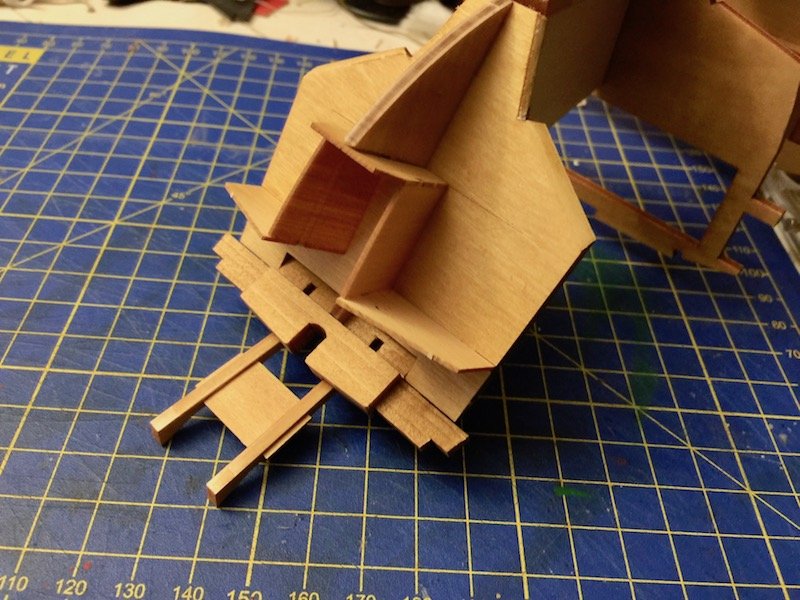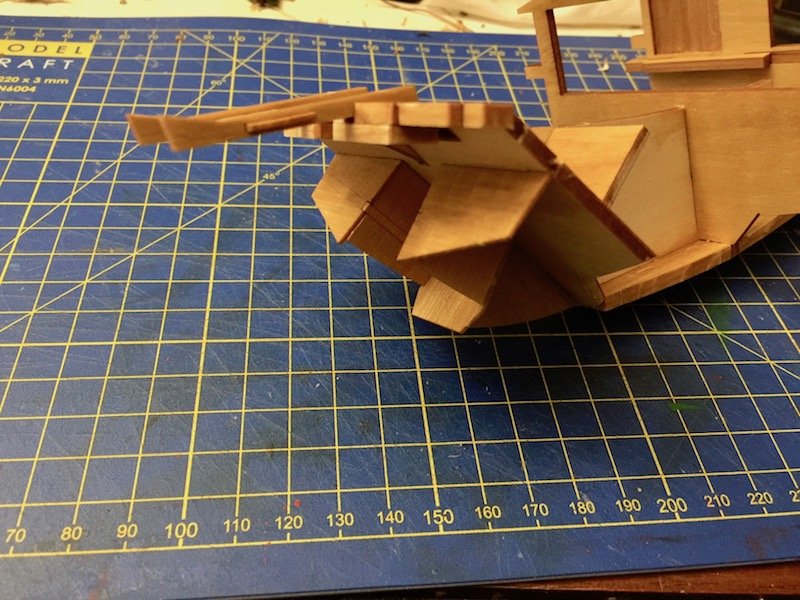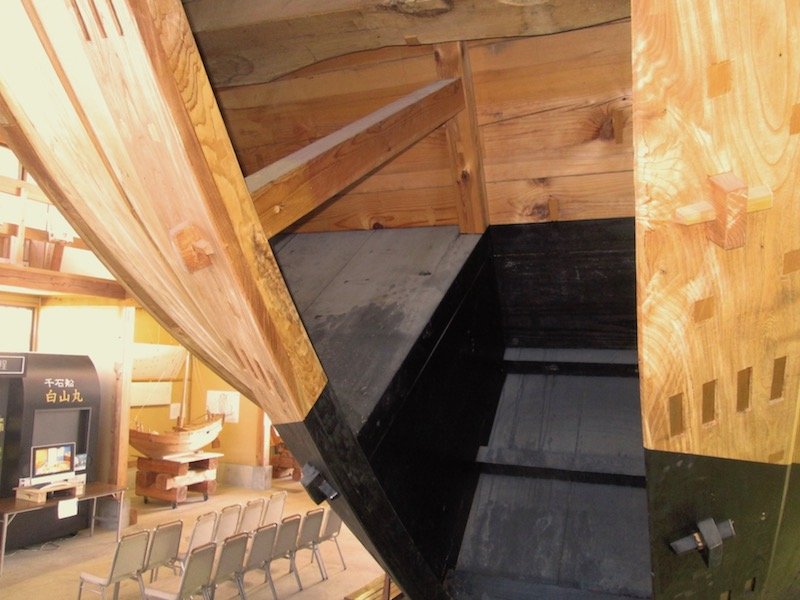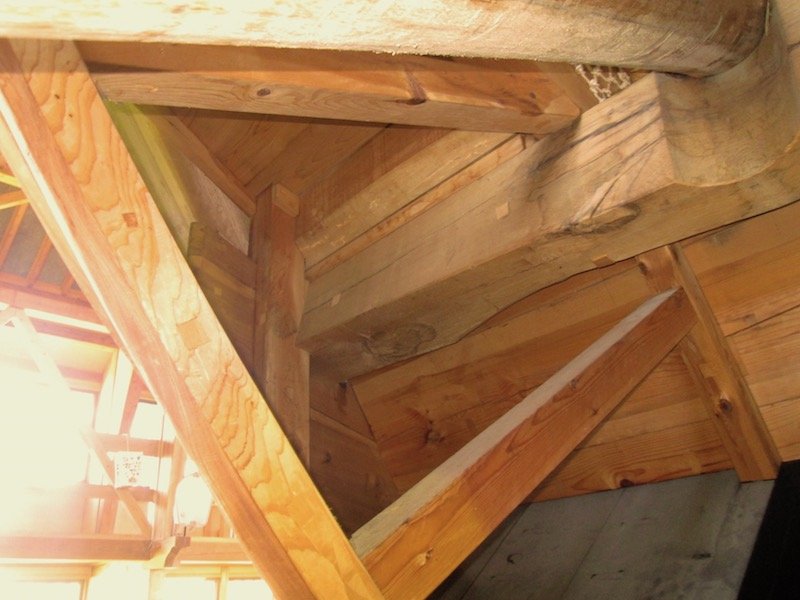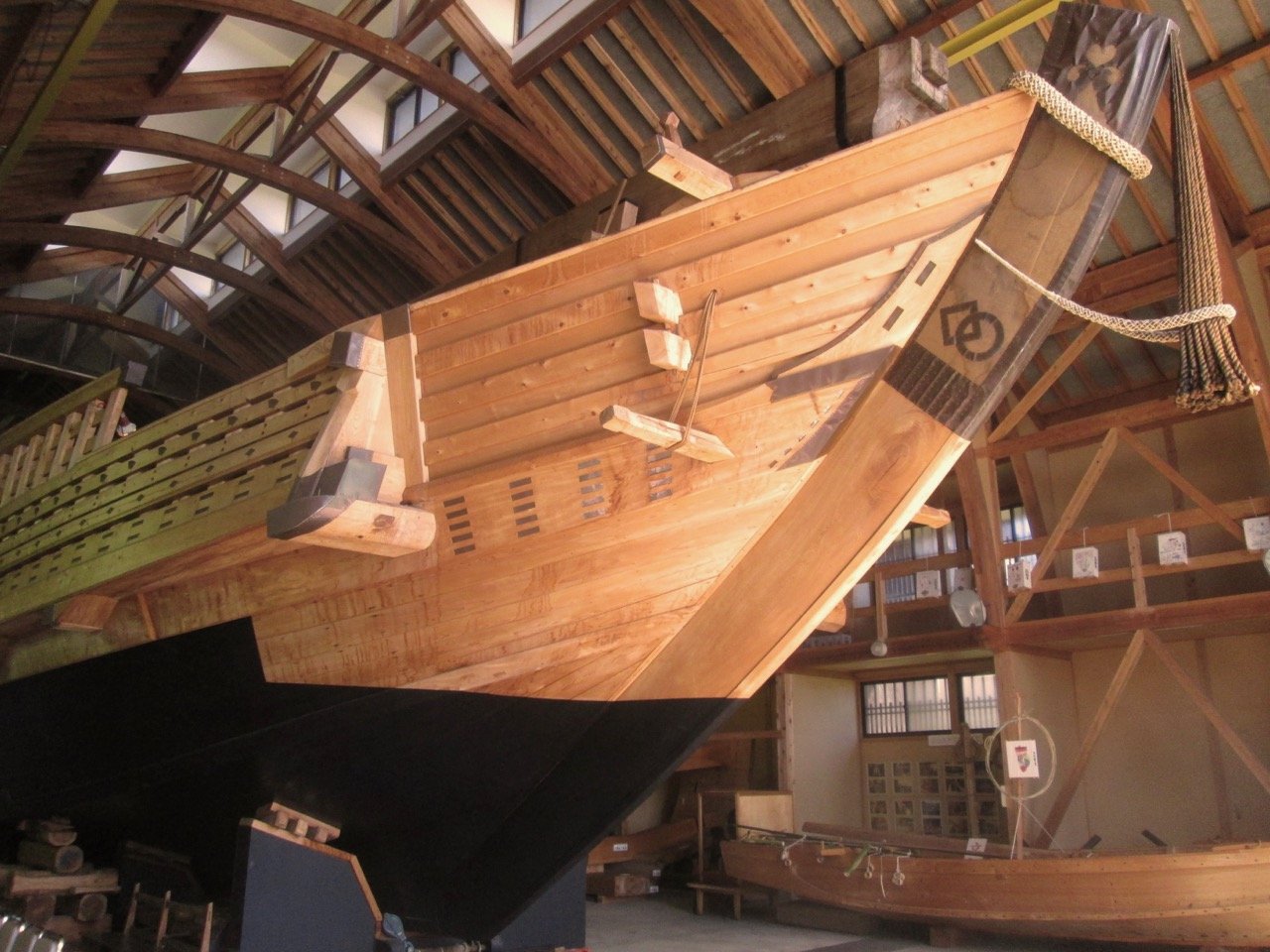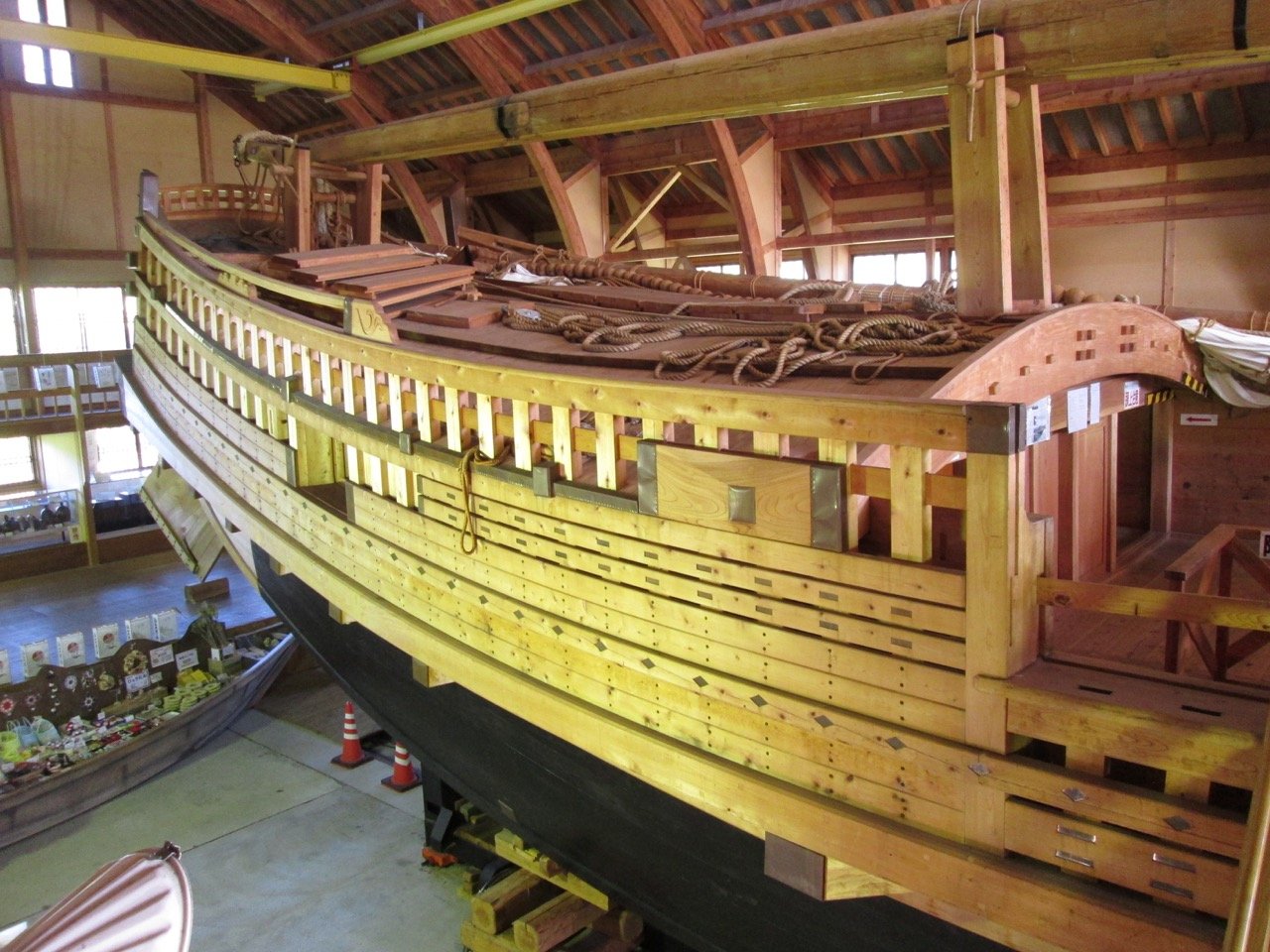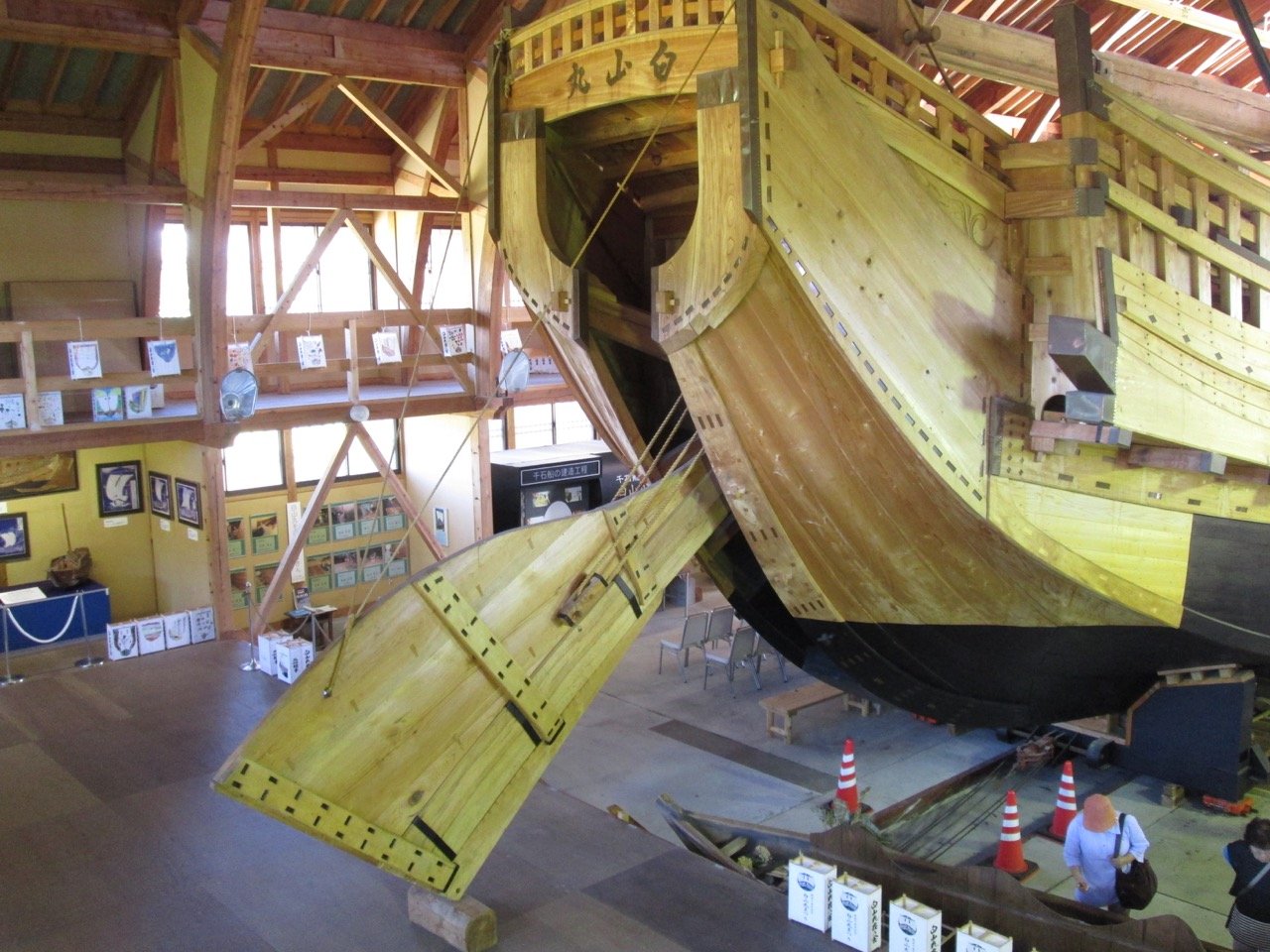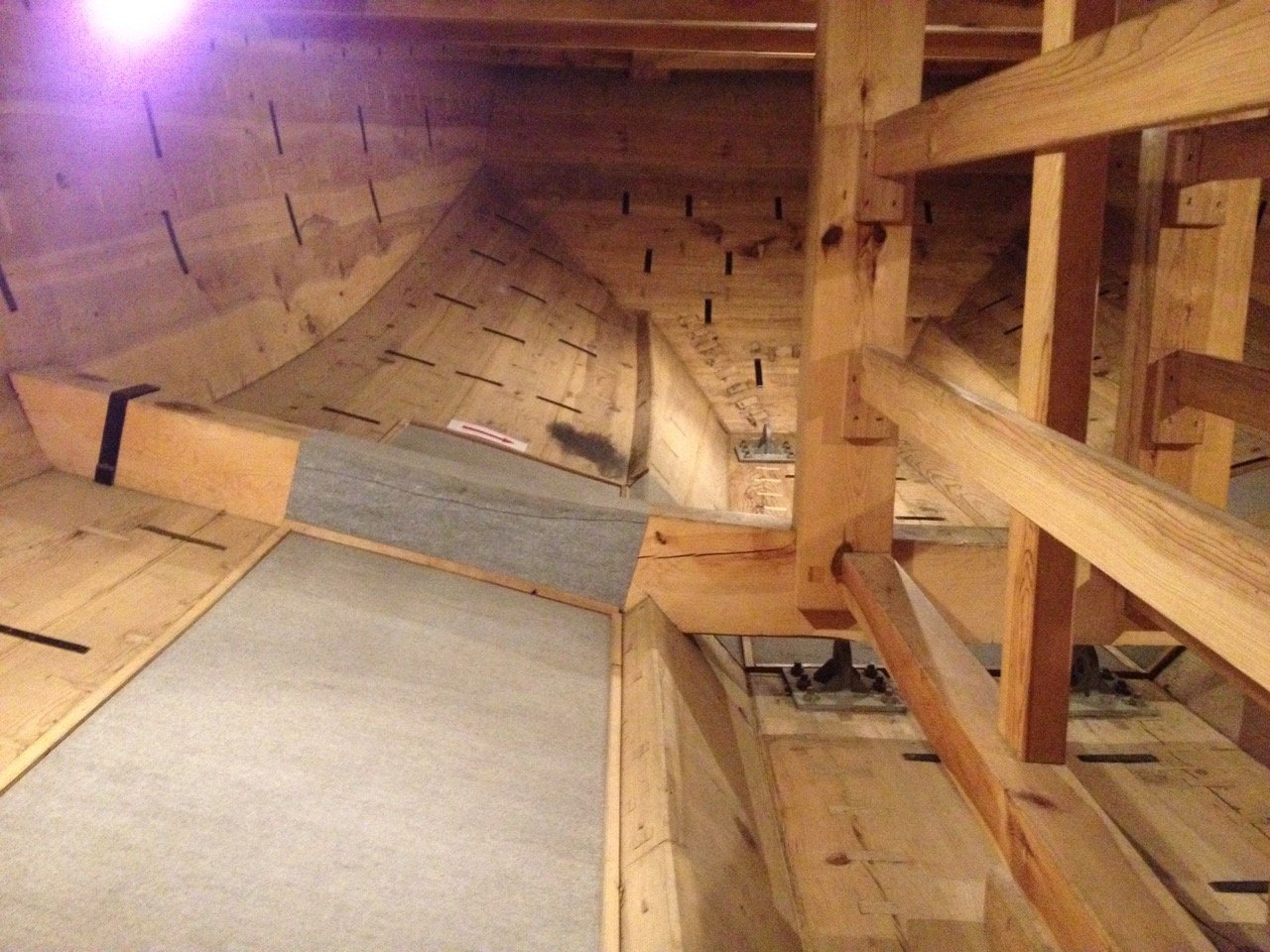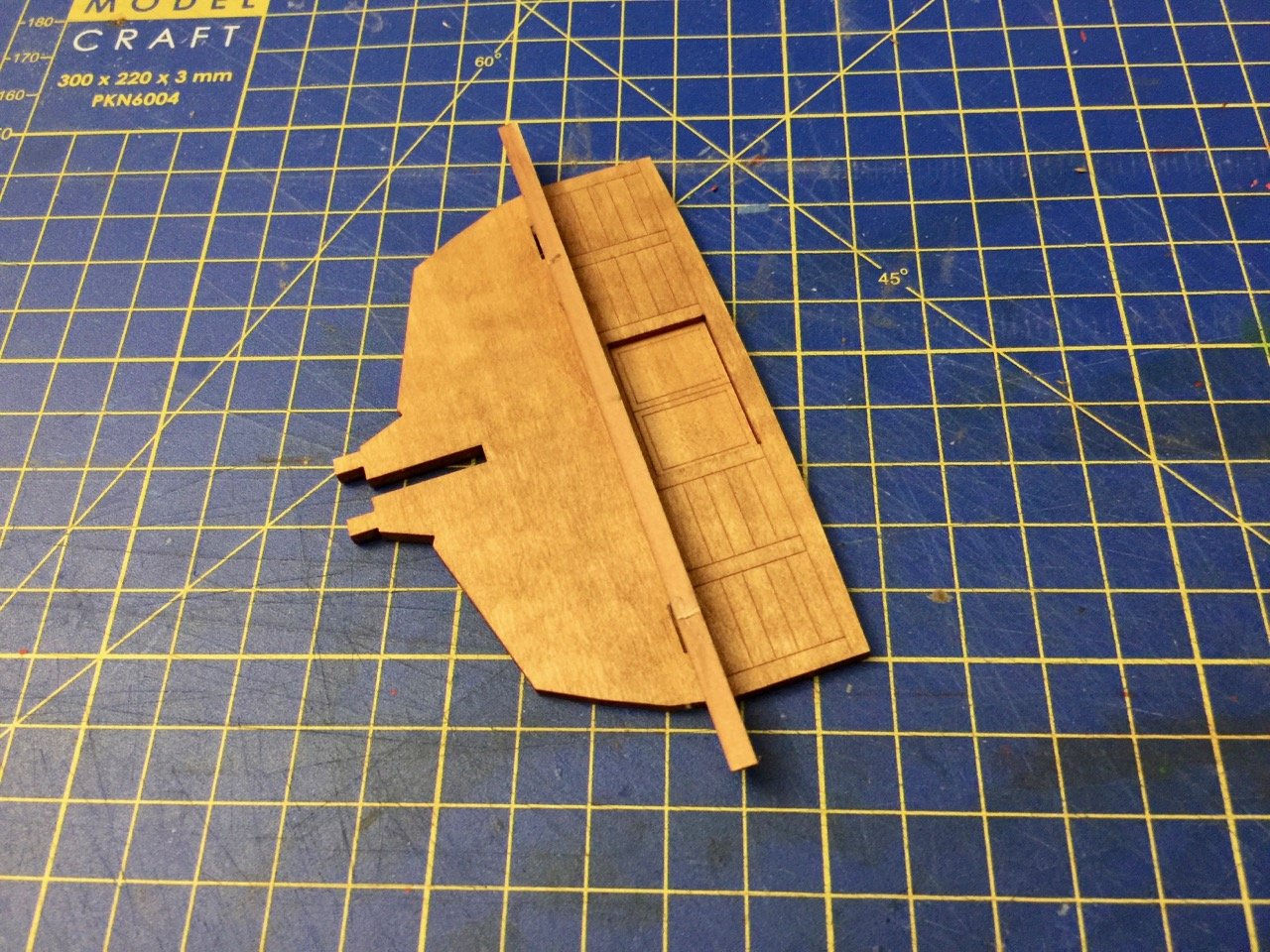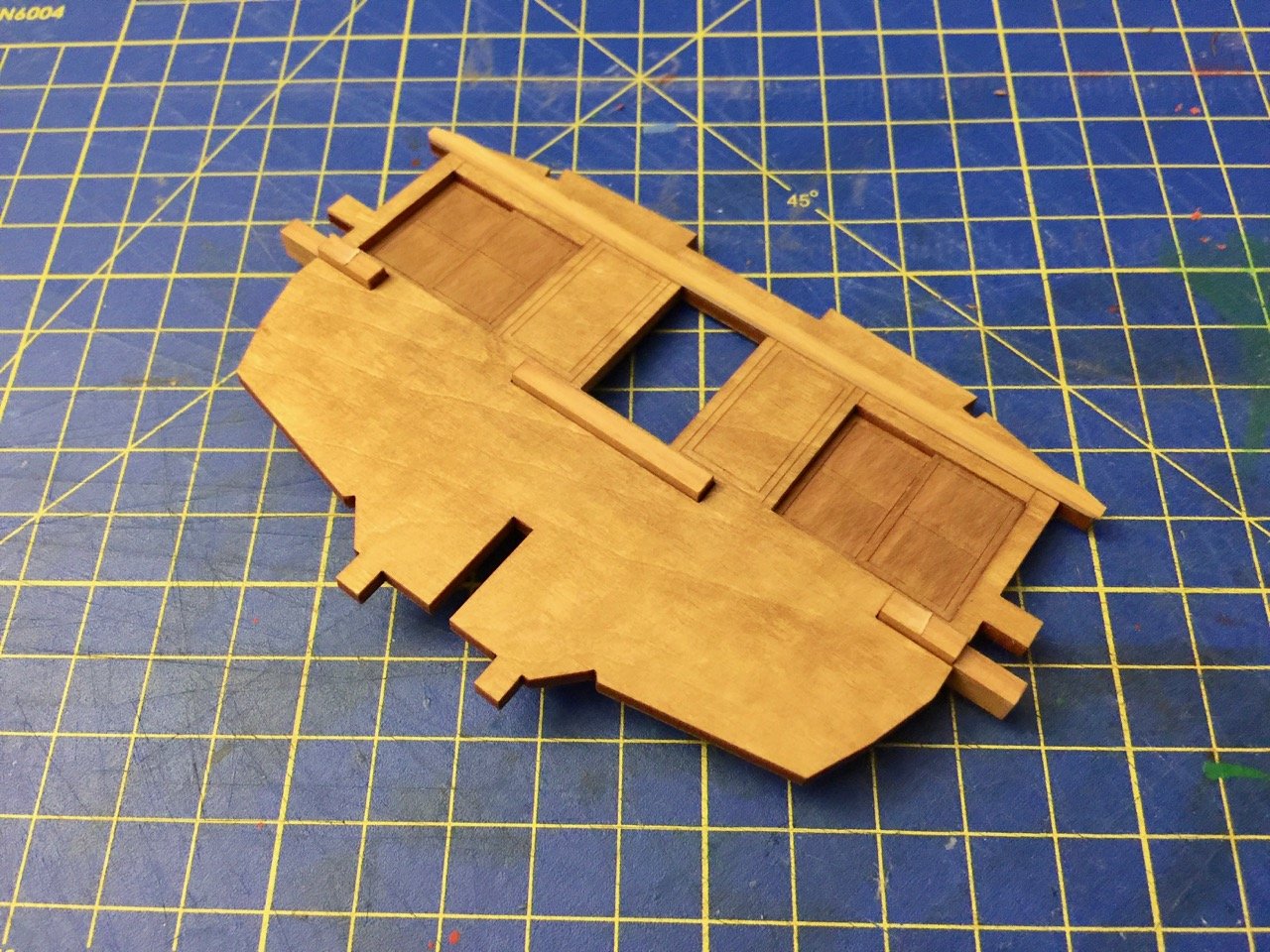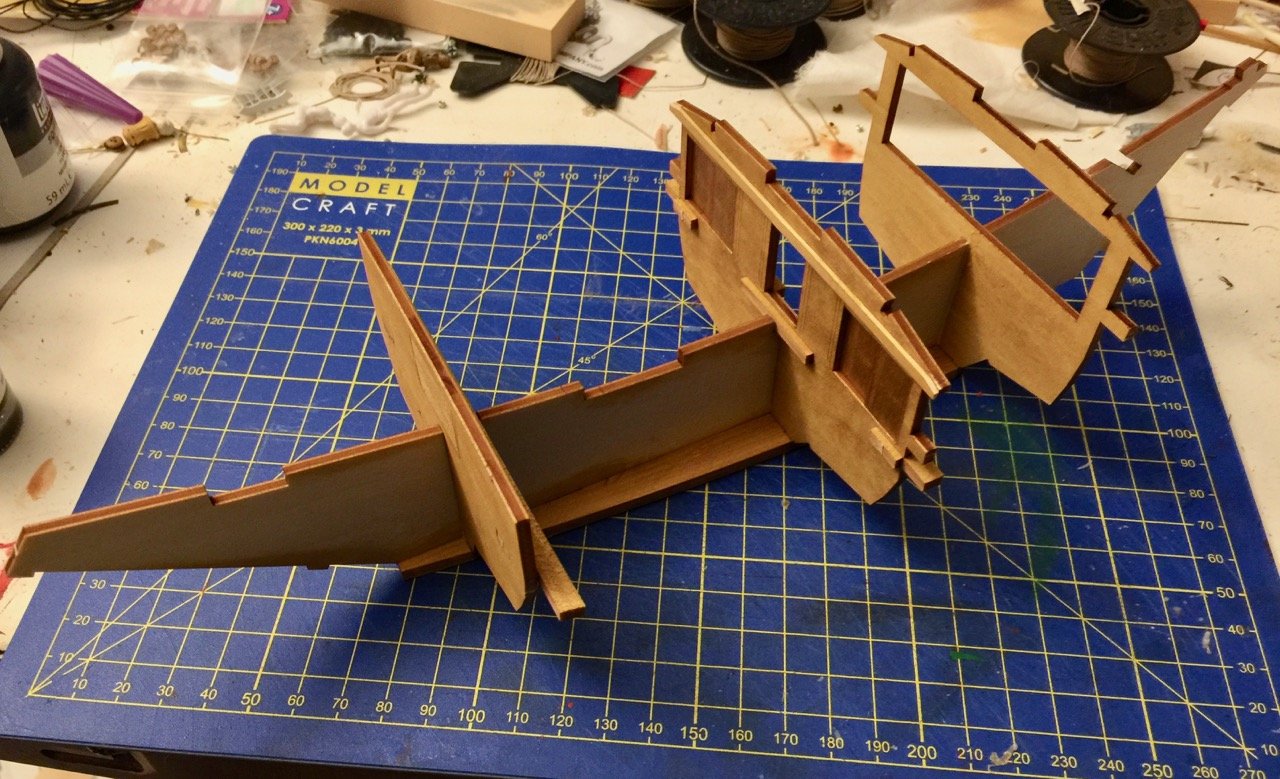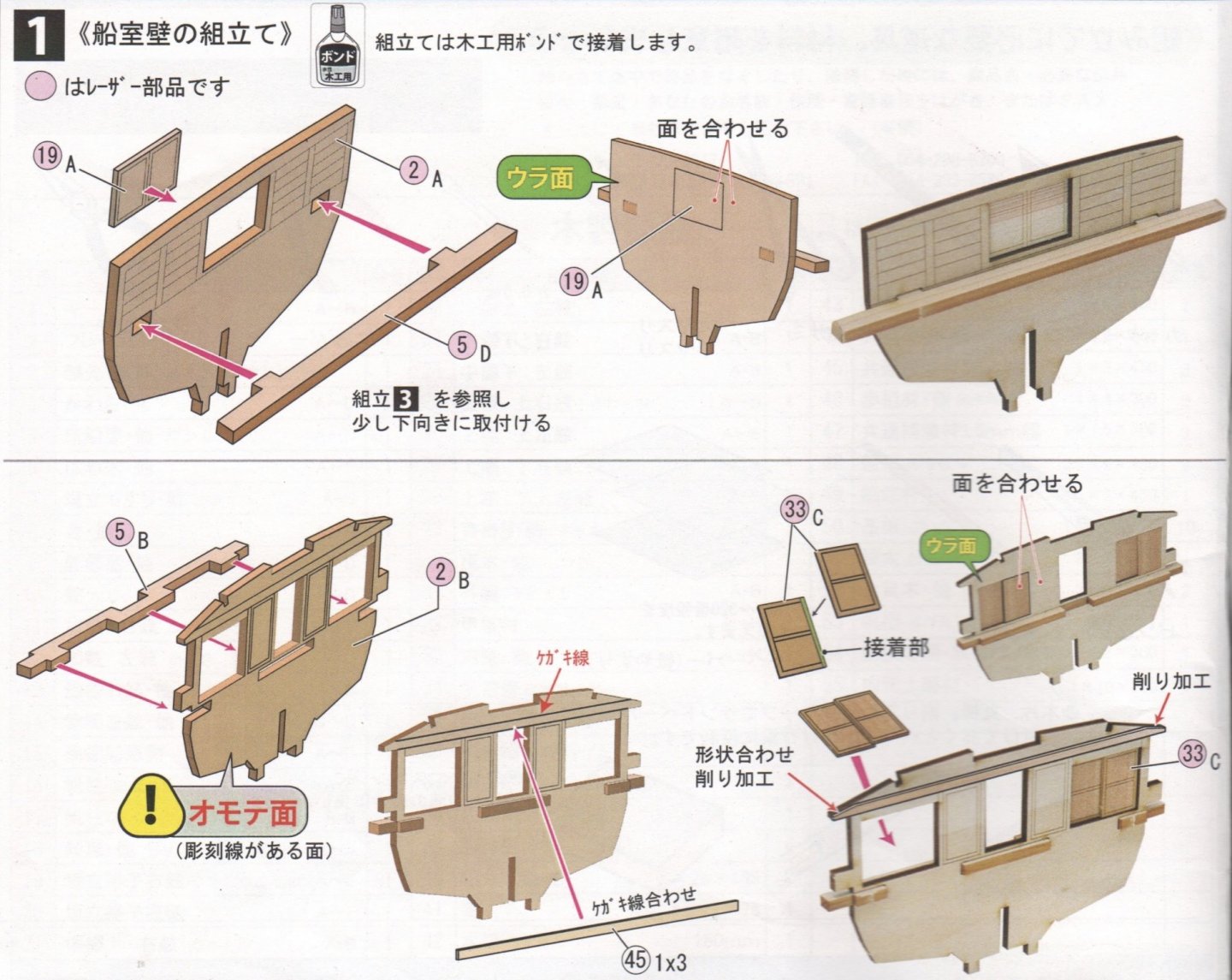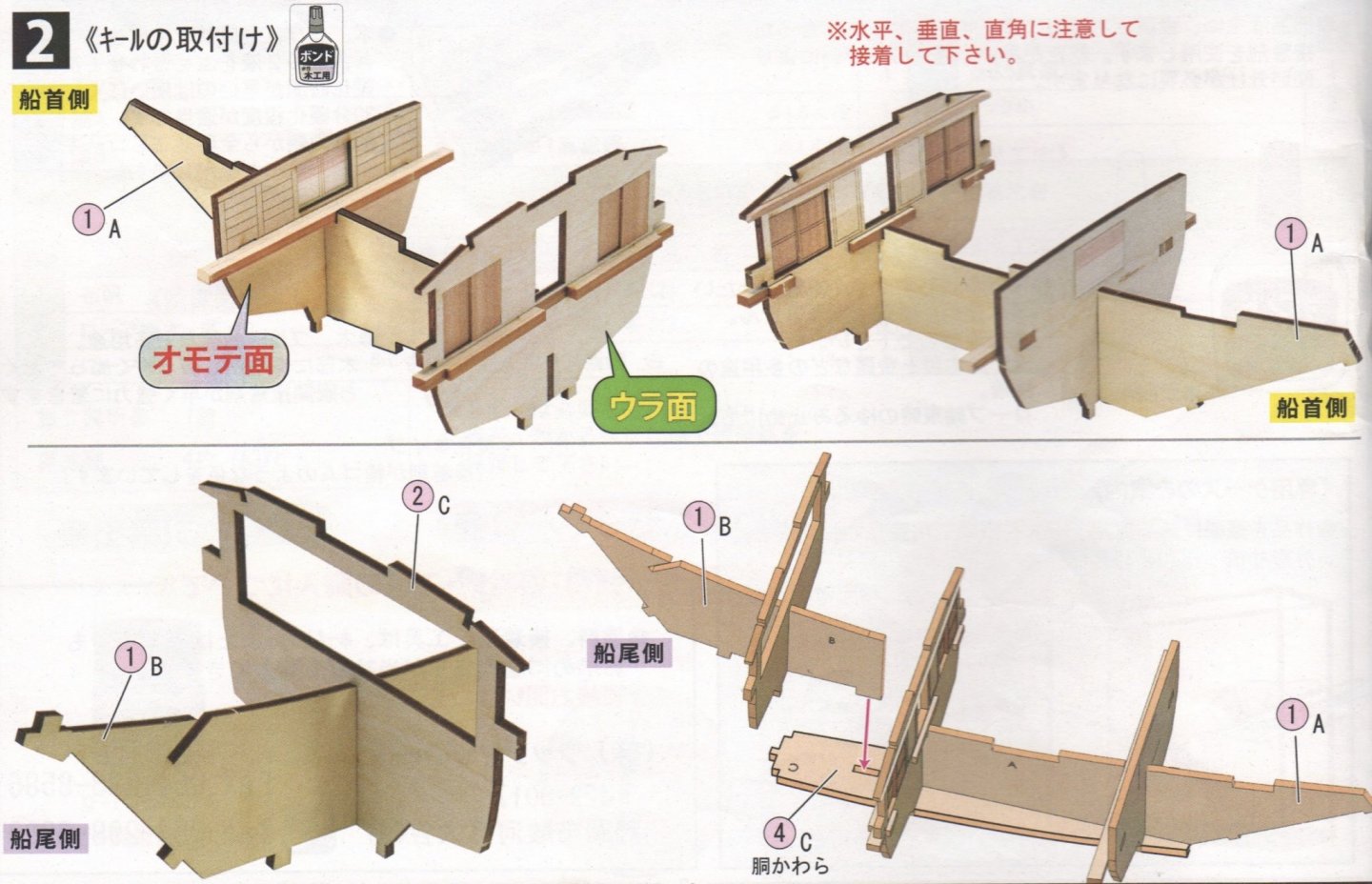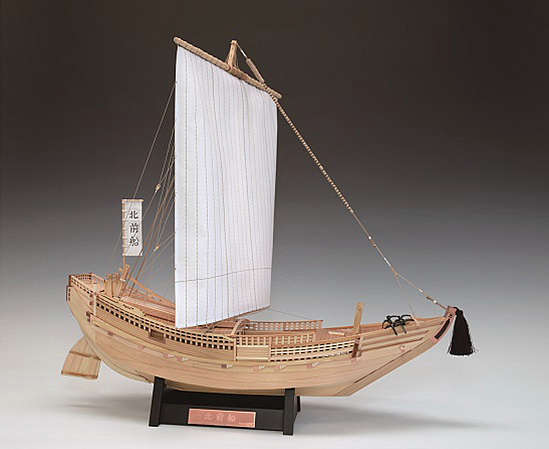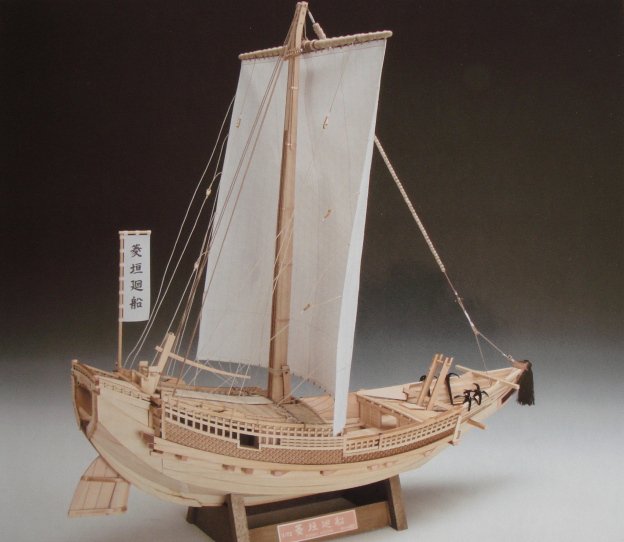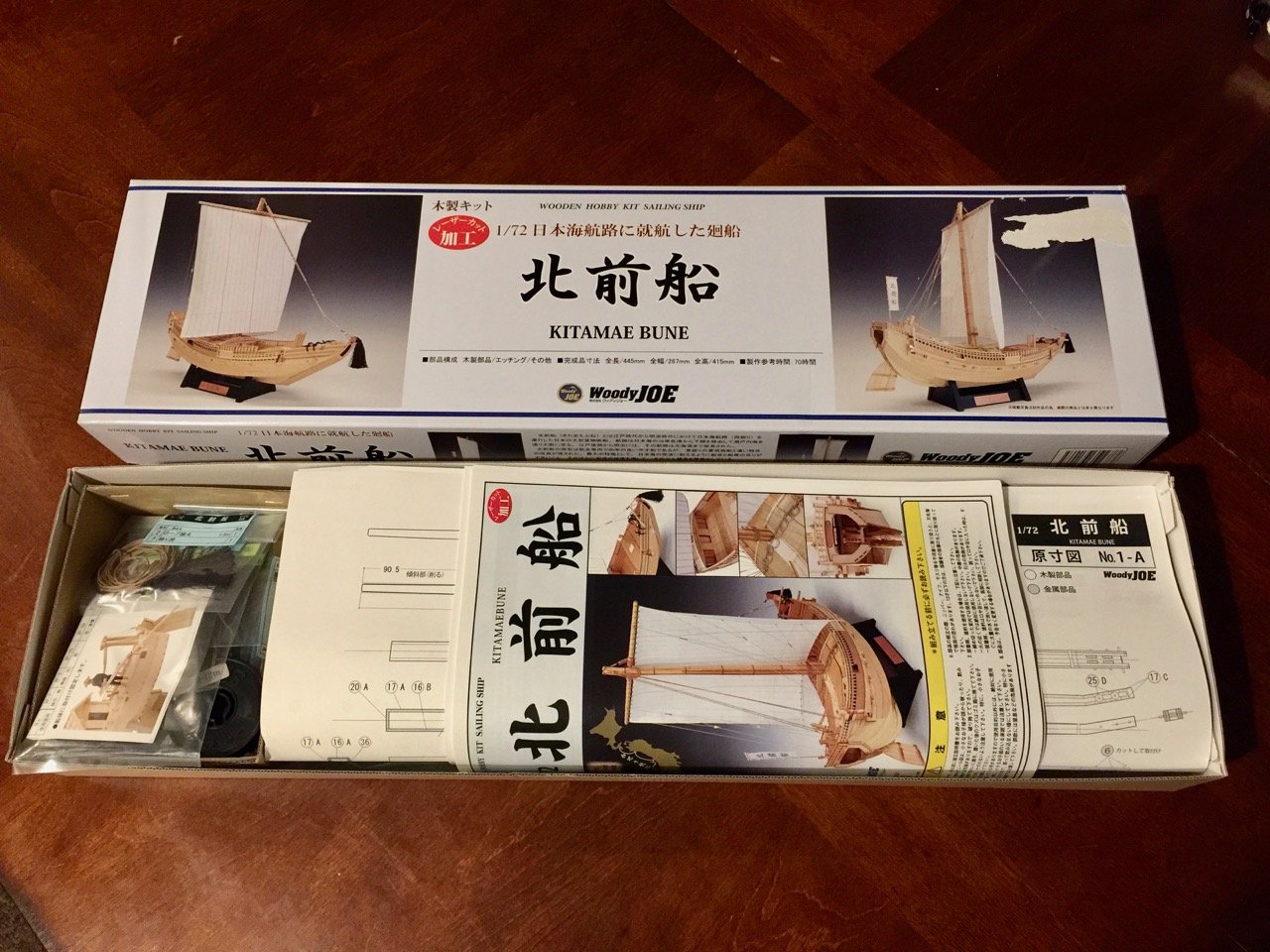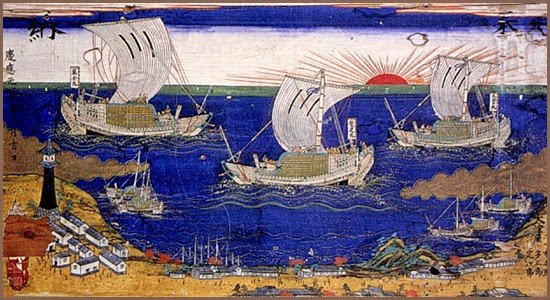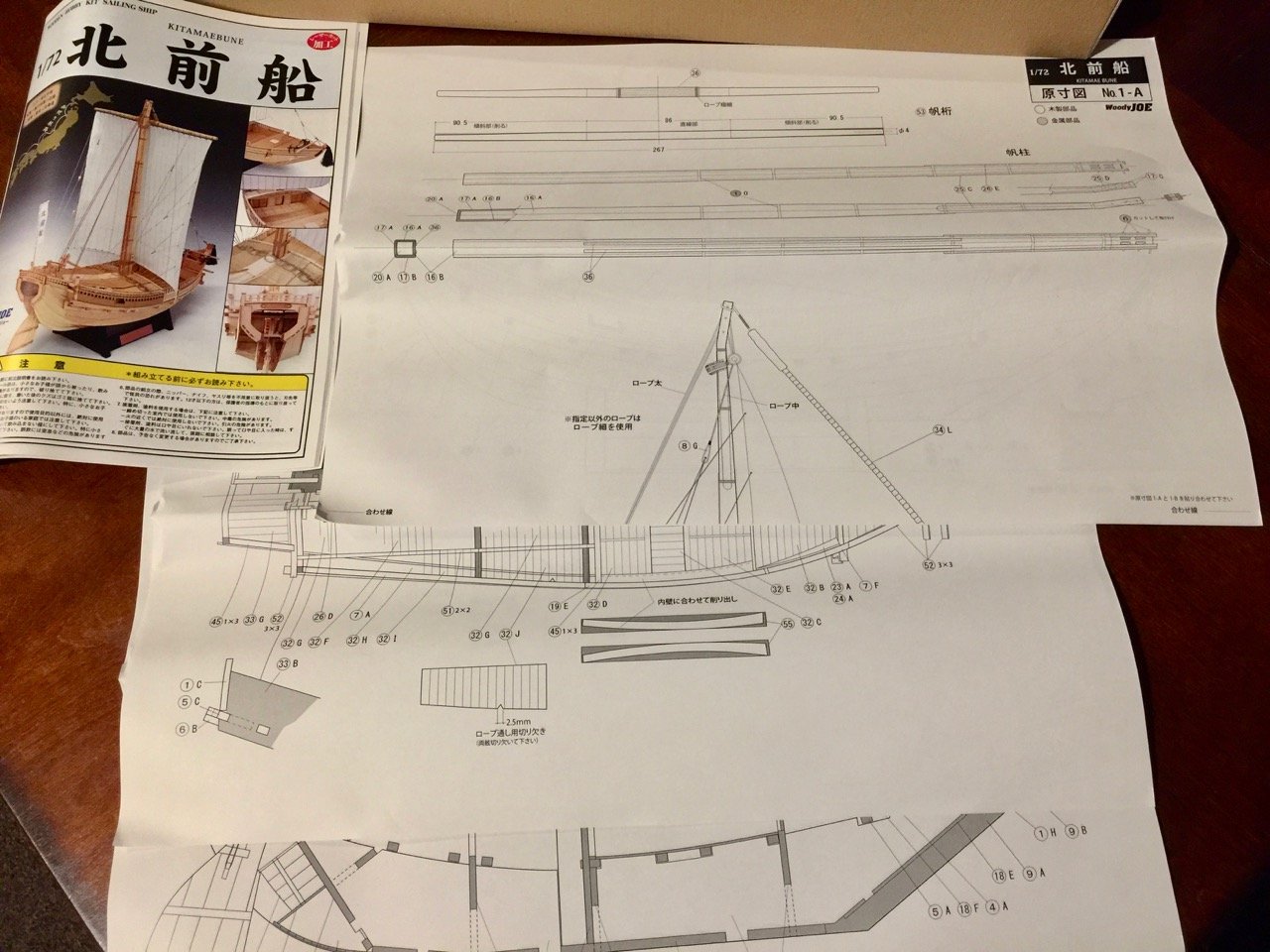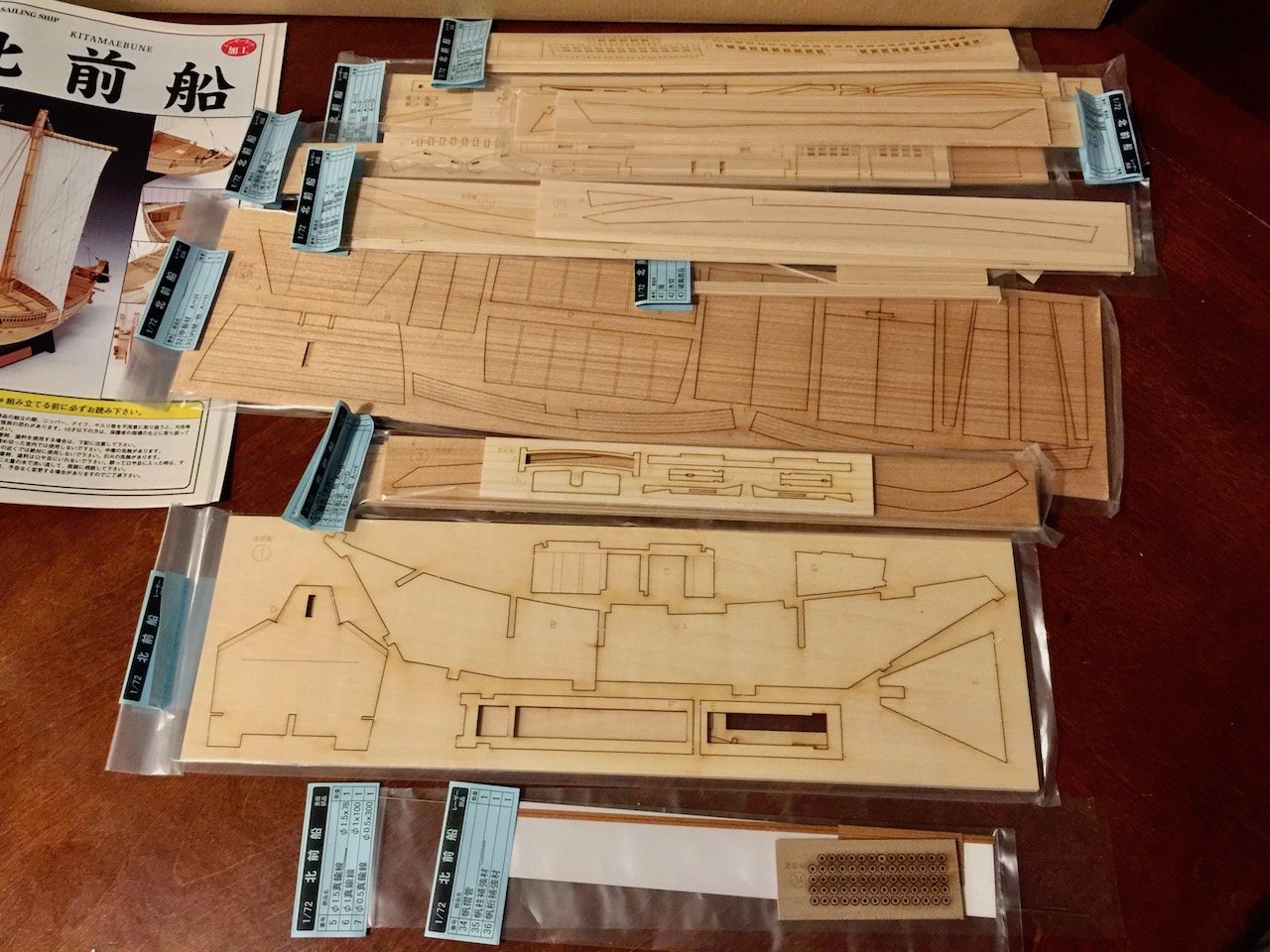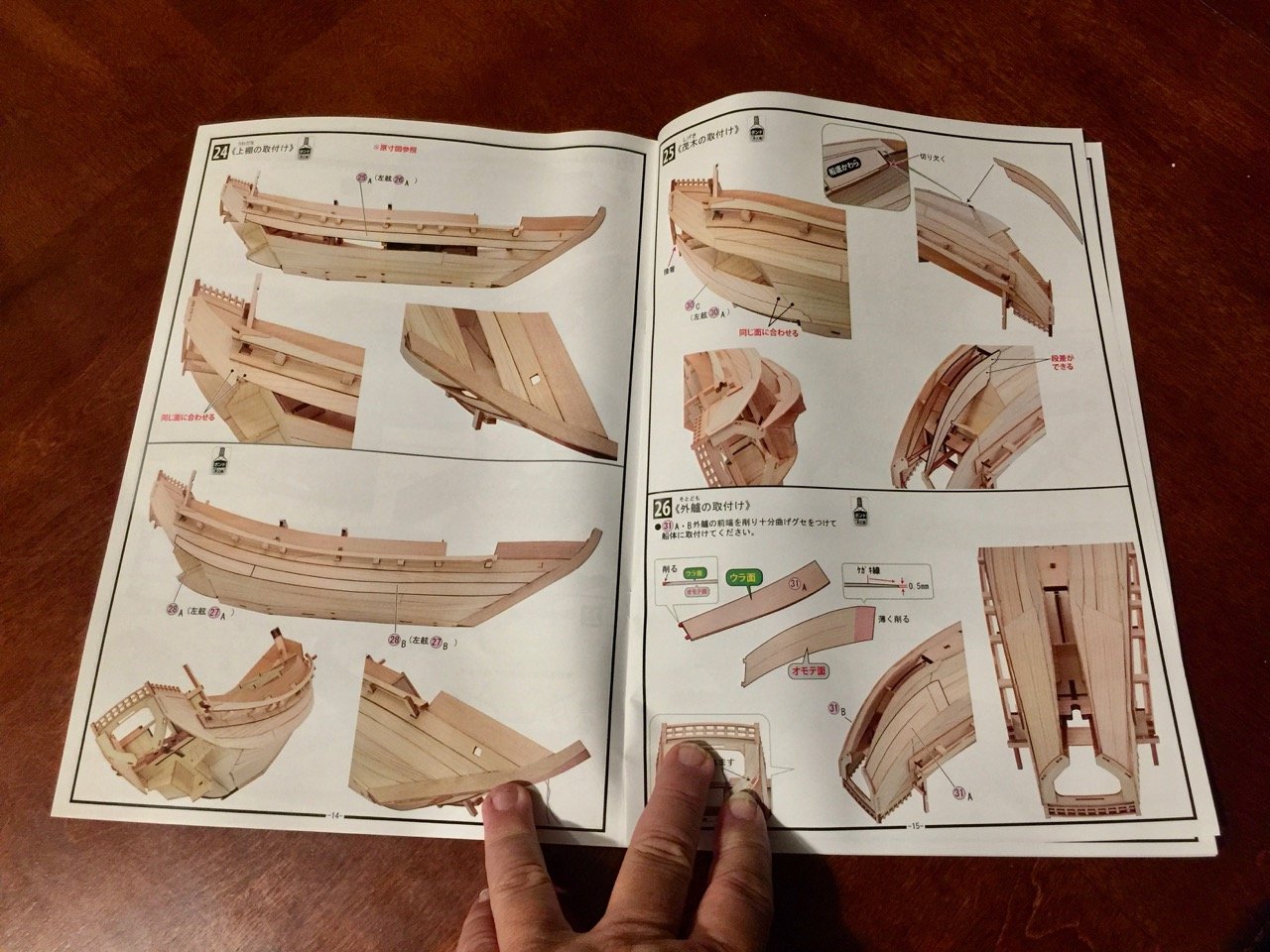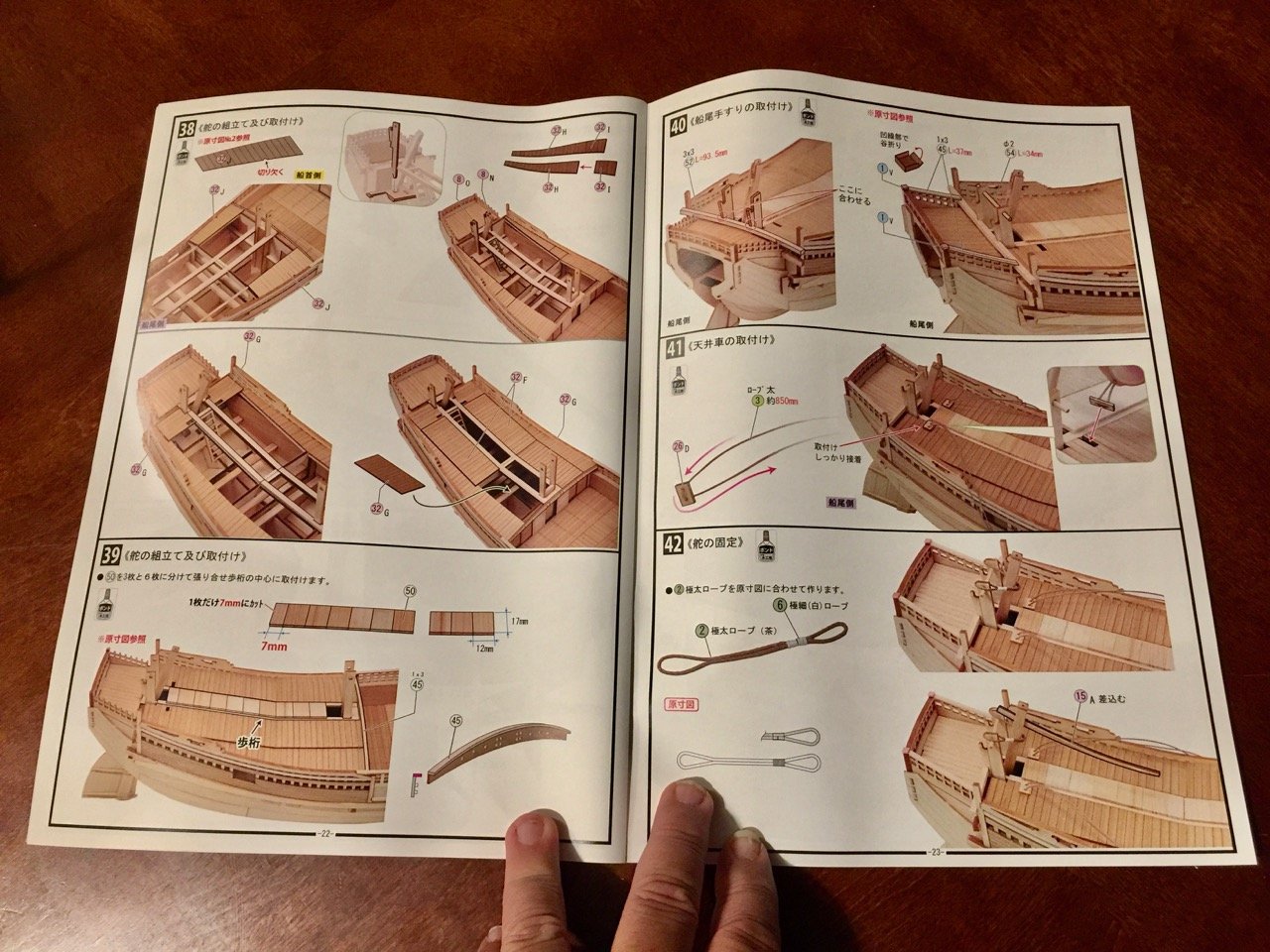-
Posts
1,860 -
Joined
-
Last visited
Content Type
Profiles
Forums
Gallery
Events
Everything posted by catopower
-
Thank you, Druxey. In fact, the painting in the first post shows three ships with the same markings. This painting was, I believe, an ema, or votive painting commissioned by the ships' owner. By the way, I was wrong about these ownership markings being black. I saw a couple photos recently showing a ship with orange or red markings, and another photo showing a ship with one marking in black and another in orange or red. But, that's the first time I'd seen a color other than black. I don't know if I'll be adding any marking on mine, as I will likely ruin the pre-printed sail, which looks very good.
-
Getting back to the build, steps 19 through 22 involve the addition of some hull planks, a plank called a noke-dana, and a piece referred to in the instructions as a dai, which is the base for the bulwarks “fences” for lack of a better term. In the photos below, the red arrows point to the noke-dana, while the blue arrows point to the dai. I don’t really understand the meaning of the term noke-dana, except that danaor tanais the term for a plank. This piece is a heavy plank that is pierced for the main beams, locking them into place. In the kit, this piece is, of course, laser cut, but is actually made in two parts connected with a scarf joint. The tricky part is that it has to be gently bent, so, again with the dampening and bending it over a large round surface. I did this after the two sections were glued together using Titebond II, which is water resistant, making sure to dampen the wooden piece, but not at the joint. Once this piece is glued into place, the beams are cut and put into place. These are among the few structural pieces that have to be cut to size from provided wood stock. These beams protrude through the holes in the noke-dana – I’m sure that on the real ship they lock into that piece in some very clever Japanese way. The dai is mounted onto ends of these beams.
-
Imai is Woody Joe's predecessor. They generally made kits in larger scales and sizes than Woody Joe does now (except for the Shin Nippon Maru kit, which is slightly longer than this Susquehanna kit). I wish there were still this and the 1/50-scale Kanrin Maru kits available. Woody Joe makes great kits, but nothing is more impressive to display than a large scale ship model!
-
It occurred to me that there are a couple other scans of a similar type of ship in Souvenirs de Marine. These scans show what I believe to be an earlier version of the ship. The other scans were from a ship recorded in 1888, which is actually during the Meiji Restoration, while this one was recorded in 1868. I've begun to notice the difference in rudder shape, and the change in the decorative work on the end of the stem. I THINK this style probably dates to the early 1800s and possibly earlier. Ships of this type didn't change much during the Edo period, which began in 1603, but the demand for coastal transports really took off with the growth of Edo. This set of drawings is very nice in that it shows what is usually called a Tenmasen, the small lighter or ship's boat. Here are two more scans that I forgot about. Not super quality as there was an issue copying them from the original book. These depict another Kitamaebune, this time showing the temporary structure and fences erected to protect cargo on the deck, which was often piled high. This last one, also recorded in 1868, shows a much straighter stem. Interesting to me is that the run of the planking on the main cabin is longitudinal, rather than lateral. By the way, the markings on the sail, in this case the vertical rectangles at the top, indicate the owner of the ship. Rectangles in different patterns seem to have been the most common. But, I've seen other shapes too, mostly circles or balls in some combination. Clare
-
Hi L.H., Those drawings are in a book called "Souvenirs de Marine" by Vice Admiral François-Edmond Pâris, first published around 1892. It's usually found in 2 or 3 volumes (they're massive). The books are available in many reference libraries, so you might start there. I got mine from the San Francisco Maritime Research Center (J. Porter Shaw Library), which is part of U.S. National Park Service. It was a free service to provide scans. But, if you PM me, I can send you the three scans I received. They are in TIFF format and about 17MB each. Or, I can send you the email address of the reference librarian there who sent me the scans. Clare
-
Getting back to model construction – here are the parts for the stern structure. Note that I've already assembled the parts that make up that stern facing. There are some interlocking parts here, and the tabs are oversized and out of scale. But, the make everything fit together nicely. During the build, I considered ways to make the model close to an actual bezaisen (general term for these large coastal transports). In the future, I may actually cut my own parts for some of these, so that the pre-cut tabs and laser etching don't show. This would allow me to add the details myself, as there are some small details, like fastenings, that aren't on the model. Still, it's a very nice kit. Note that the protruding beams at the stern are now glued to the stern facing. The whole assembly fits quite nicely into place. For a future scratch-building project, it's nice to be able to see that this section can be dealt with as a whole separate "module" like this. From the photos, I can see where the model needs a little touch-up with the wood dye where the tabs left from the laser-cutting were attached. This happens as I apply dye to the entire laser-cut sheet before removing the parts. Clare
-
To me it's a bit mind boggling how complicated the design of the Japanese coastal transport can seem. But, I'm sure it makes perfect sense to one who understands the whole design. I'm starting to "get it" when I look at some various parts of these vessels. At least I THINK I am. Then again, when I give thought to scratch building one, I have a hard time trying to figure it out, even when I've seen detailed drawings and numerous models and all. I saw a model that someone had built from scratch, and they clearly didn't quite understand the structure of the ship, and the model looked very weird. I know if I tried, it would look really weird too. Either that or I'd just get stuck at some point (very early on, I'm sure) and wouldn't be able to continue. By the way, I just realized that I didn't reference one of the more detailed drawings done of an actual Kitamaebune. The following is from the Souvenirs de Marine, recorded in 1888. This ship was measured in Hyogo, Japan, in 1888. By the way, this is the same type of ship of the story of the 3 Kichi's. This sad tale involves one of these ships, the Hojunmaru, that set out to deliver a cargo of porcelain and rice to Edo 1832. Just off the coast, the ship sailed into a typhoon, and her 14-man crew had to cut down the mast to keep the ship stable after she lost her rudder. Without sail or rudder, she was blown out into the Pacific's Kuroshio, or "Black Current", which carried the ship northward toward the Arctic, across the Pacific below Alaska, and down the coast of Canada, to Washington state. After 14 months at sea, 3 of the crew survived, mostly from scurvy. The 3 survivors were Otokichi, Iwakichi, and Kyukichi. Two of the survivors were no more than 16 years old. Iwakichi, the ship's navigator, was the oldest at 29. Reportedly, some Makah seal hunters found and boarded the wreck, took a few items from the ship, and took the survivors with them, where they were cared for, but enslaved. Word reached the Hudson Bay Company at Fort Vancouver and the supervisor John McLoughlin, who set out to get the sailors released, and attempted, but failed to return them to Japan. There was apparently a Japanese film about the story, which starred Johnny Cash in his later years as John McLoughlin. You can read more about the Japanese castaways here: https://www.historylink.org/File/9065 Clare
-
Thanks, Michael. Well, the next step is to add the bulwarks pieces. These are single, large, laser-cut pieces that need a little dampening and pre-bending. Before attaching this piece, I did a lot of test fitting. But, all the pre-cut holes and the already installed "beams" that fit through them pretty well lock the pieces so that they go exactly where they're needed. The only issue I ran into with the installation is that the forward edge of this piece is straight didn't fit the curve of the stem very well. I would have sanded a little, so it fit better, but that would then change the length of the piece ever so slightly. And, it's been my experience with these kits that these little changes propagate through the model and cause some other unintended mis-alignment. So, it's best to leave things alone. One possibility it to use a little bit of filler, but I didn't think the issue was noticeable enough to warrant it. The filler might just make the spot stand out like a sore thumb. After this, the hull planking continues. Again, the pieces are laser cut. This piece slightly overlaps the edge of that "garboard" piece installed earlier. The instructions say to consult the plan drawings, but I found nothing useful in the plan drawings that showed this piece. In fact, the end of the piece seems to fall in a different location in the drawing, so it just created some unnecessary confusion. The instruction booklet is clear enough here. Here you can see my high-tech planking clamps in action. You can also see below that I couldn't get the forward edge of this piece to fit perfectly flush with the stem, creating a sliver of a gap. I seem to recall having a similar issue with the Higaki Kaisen kit. I didn't worry about it, as this area of the hull will get painted. Next will be to build up the stern structure... Clare
-
The stem is a 3 piece structure that's built in exactly the same way as the one on the Higaki Kaisen model. This is the only part of the kit that requires a great deal of tapering. As the taper has to be just right in order to cover the end with photo-etched copper pieces provided in the kit, it's necessary to use one of them to help judge the correct amount of taper. By the way, the snippets of the instructions are posted here with the permission of Woody Joe. Below, you can see the piece glued into place. The internal framing helps out a lot here. Also notice that I have attached a long piece on the back side of the stem. That piece needs to be curved slightly, and with hinoki, or Japanese cypress, you only need to dampen the wood to get it to bend. Of course, it helps that the wood in the kit is all pretty thin. But, DO NOT try to bend it dry. This wood is very brittle when dry! The rope you see is nice quality stuff and comes in, I think 4 sizes in the kit. Here, a length is passed through a sheave assembly that's attached to the back of the stem. Inside there is a brass rod axle passing through little wooden pulley. This piece of rope is tied off, so it doesn't slip out later. You might also see here that the plank that might be described as a garboard plank is glued into place. Prior to adding this piece, a thin square cross-section strip has to be glued to the lower edge of that bottom plank. This completed assembly is a kind of box structure that serves as a keel, even though the ship is sometimes described as keel-less. Again, the plank sheets need to be dampened slightly. The planks are then easily pre-bent, slightly. You'll also note the tabs from the bulkheads and frame that show through the bottom piece. In my case, the bottom of the model will be painted, so these won't show very clearly. You can also see here that the main deck is glued into place. This is a 3-piece deck that has to be glued together before installing here. It is very thin and seems a bit delicate. I would put something underneath to support the seams between the deck pieces, except that there are beams that will pass through this area later in the build, so it's best not to mess with it. It seems a bit early to install the deck at this point, as it prevents me from getting down to the inside of the hull to add any reinforcing to the inside of the hull later. But, I don't know how easy it would be to install this deck at a later stage. From looking ahead, it looks like it shouldn't be a problem, but you never know. This brings the model up through most of step 12. 46 more to go! Clare
-
Thanks again for the nice comments. Some manufacturers target the model scale so they can standardize on box sizes to keep costs down. I'm pretty sure Amati does that, which is why so many of their kits, aside from the Victory Models line, are of so many odd scales. I think Occre is that way as well. So, it wouldn't surprise me if that's a target. Also, a lot of people in Japan live in smaller spaces, so it's probably good to keep the completed models at a manageable size. But, yeah, it would be nice if the models were larger, as I like to put them on public display. In their pre-laser cutting days, their traditional Japanese ship model kits were larger – more like 1/60 scale. Better size for display purposes, but they were not as detailed. By the way, just found this on the web. Maybe I should try LEGO next time??? http://www.lets-brick.com/jpn/my/c1703_kitamae_bune/lego_my_a.html Clare
-
Thank you Mike, Gary, andante... Regarding magnifying visors, I couldn't do anything without a set, so it doesn't really matter that I'm working on a smaller scale. Anyway, the parts in this kit aren't that small. The tiny stuff will come when I add extra details much later in the build. For now, the next step in construction is to build the todate (tow-dah-tay) or transom. Unlike western ships, the transom on the Kitamaebune is somewhat buries inside the stern area of the ship, protected by the hull planking and some other wooden features. This is a trademark of most Japanese wooden watercraft, big or small. Again, instructions warn you to make sure that the beveled side faces aft. The instructions aren't entirely clear as it refers to the side that faces outward, and is visible, as the "front". Or at least that's the translation I get, but that side actually faces aft. Perhaps a better translation is "face". Anyway, if you read ahead and test fit things, it's all pretty clear. The kit has nicely laser-etched lines to indicate how far to bevel the transom piece. And then here are a couple views of the actual transom area of the Hakusanmaru... One thing that is noticeably missing from the kit are those braces that support the hull planking that wraps around behind the ship. By the way, while this kit's interior is a built up framework and all, below is a photo of a cross-section model at full scale, showing the beams supporting the hull at midships. At the base is a box-like keel structure. And, if you look closely, you can see the nails in the edge of the bottom planking. Clare
-
Thank you, Druxey! By the way, I just found a site that gives a lot of the history behind the Kitamaebune and its influence on the spread of local culture across Japan. It's very detailed and is available in English. http://en.kitamae-bune.com After the graphic loads, scroll down to just underneath and click on the button "What is Kitamae-bune?" The rundown is that Kitamae-bune were trade ships that operated from the early 1700s until the early 20th century. These ships came down the Japan Sea coast (the western side) from the northern port cities of Hokkaido buying and selling goods along the way. These ships were owned by individual owners who became rich from the trade, and many shipowners grew wealthy enough to have small fleets of Kitamae-bune. These ships spread culture throughout Japan, as sailors learned songs and dances in one location and brought them to other locations. They also brought popular goods to areas that did not have them, creating industry and widespread availability of many foods that became common standards in Japanese cooking. There's much more on the site linked above. Clare
-
One thing aiding me in this build is a trip to Japan I made in late 2016, where I visited the Kitamaebune reconstruction ship Hakusanmaru on Sado Island. I made sure to take lots of photos, as this is probably the best preserved of four reconstructions built in recent decades, and may currently be the only one available for the public to actually climb down inside. I did take plenty of interior photos, but those don't really help with this model, as none of the interior is visible anyway. I do have another Higaki Kaisen kit waiting for me, so I'll be saving those details for that future build. As for the model construction, the first few steps are very simple, and involve the construction of the internal framework. Just a note here that these ships did not have much of an internal framework. They relied on heavy, wide planks, mostly edge fastened together using large, flat, iron nails, and what resemble big, iron staples. Here are a couple photos showing some interior below the main deck. The first is from about midships, looking aft. The second is from about the same position, looking forward. Those three straw bales in the second photo is a sample cargo of bags of rice. Getting back to the model itself, here are a few photos of the start of construction. The wood is naturally a very light color, like basswood, so I used a mixture of analine dye to add some more natural coloring. As I've described before, the product I'm using is called Transtint, and it comes in rather pricey little bottles. Luckily a few drops goes a long way. I recently came up with a mixure I liked, which I felt was pretty close to the right color. In a 2oz glass jar mostly filled with denatured alcohol, I added 24 drops of Dark Vintage Maple, and 12 drops of Amber. My experience is that to complete a model this size will require about 2 bottles of this mixture. I went ahead and applied the dye to all the laser-cut parts, and let that dry before I started construction. The first two steps of the build are nice and simple. Here's a scan of the first step. I have asked Woody Joe for permission to include scans of their instructions in my posts for illustration purposes. Construction is pretty straight forward. The special yellow text in the green bubble is a note that you're looking at the back side of the bulkhead. The red text in the gray bubble is indicating the front side. This is very important here, as there are laser-etched lines in several of the parts that are supposed to be visible on the model. Here are my completed bulkheads... The next step completes the internal frame... Notice that the term "front side" means the exposed side, not the side that is towards the front of the ship. And, don't forget to look for the laser-etched part labels. These should go on the inside of the ship, where they won't be visible. Yeah, I know... There's a lot of junk in my work area!
-
This is a project that's already pretty far along, but I realized that it would good to post my build notes here in hopes that it might encourage another ship modeler to build this kit from Japan's Woody Joe. The Kitamaebune (key-tah-mah-eh-boo-nay) is a 1/72-scale laser-cut kit of a Japanese coastal transport, similar to the Higaki Kaisen (he-gah-key-kah-ee-sen), which I built a few years back. This kit replaces their less accurate Kitamaebune model, which did not have laser cut parts, but was actually nice in that it was of a larger scale and made for a bigger model. The main tradeoff of the smaller scale is that it matches the scale of the Higaki Kaisen kit, and 1/72 is a commonly modeled scale, just not that common in ship modeling. The kit was released somewhere around February of 2016, but I had been too busy with other projects to take too much notice, and I didn't order the kit until early 2018. Even then, I didn't really have time to work on it, but finally broke down and started working on it last December. Kitamaebune model photo from Woody Joe: Higaki Kaisen photo from Woody Joe I ordered my kit, along with all my Woody Joe kits, from Kazunori Morikawa's Japanese online shop Zootoyz.jp. I can't say enough about his great service and support. The price for the kit, with express mail shipping included, came to about $270, and I had it about 10 days later. One note of caution: Be careful perusing his website, because you'll find all sorts of really interesting looking ship, temple, old house, and castle kits there. Woody Joe suggests that the kit should take about 70 hours to build. Building cautiously, which I highly recommend, I expect to at least double that time. Plus, I have some ideas about adding details, which will add many hours to the total. But, this is a good number to use for kit comparison, as the Higaki Kaisen model is listed to take about 100 hours. That's 50% longer. So, this kit is a much quicker build. The kit looks much like any other Woody Joe kit, with laser-cut parts on small sheets, bagged and labeled. Same goes for strip woods, dowels, and a few metal parts. The wood used in the kit is mostly Japanese cypress – Hinoki, in Japanese – which has a wonderful aroma that hits you as soon as you open the box. The plans are well illustrated, but text is all printed in Japanese. There's not a great deal of text, however, and what there is can be translated by Google Translate app on a smart phone. Overall, it's clear that this is a simpler model than the Higaki Kaisen kit. Many assemblies have been simplified by the use of laser-etched parts for the deck planking, for example. Also, the interior framework structure makes this go together more like a traditional ship model kit, with an inner keel and bulkheads. Being that I've actually gone through most of the build as I'm writing this, I can issue one word of caution: This kit, while a simpler build than the Higaki Kaisen kit, has some places where I feel the design of the kit could have been better. I ended up having a bit more trouble with this build, but nothing insurmountable. Building the more complex Higaki Kaisen kit first may have benefitted me here, as I was familiar with the various parts of the ship. The most important word of advise I can give here is to do a lot of test fitting, look ahead, and check the plan drawings, to make sure the parts fit exactly as they are supposed to.
-
This is very sad news indeed. Mitch was such a great guy and really made me feel so welcome at the NRG conferences. My sincerest condolences.
-

kit review 1:120 USS Susquehanna - WoodyJOE
catopower replied to James H's topic in REVIEWS: Model kits
Nice kit review, James! Glad to see you got a review kit from Woody Joe. I'll add that everything about this kit is pretty much standard Woody Joe product. Plastic blocks and deadeyes are standard in all their kits, as is the beautiful packaging and indexing of the parts. Very much Billing Boats like. And, as you point out, these parts are easily swappable for your favorite wooden deadeyes and blocks. Though, my preference is still the Syren stuff 😉 Their kits can sometimes be a little light on some details, but they also tend be pretty accurate on the measurements and scale, so it's very easy to do some of your own upgrades. I agree that RC is not the intention of the motor addition – it's more of an add-on capability "just for the fun of it". I'm not sure that one can actually buy direct from Woody Joe for shipment overseas. So, I'm surprised to see the store link. I've received things from Woody Joe before, but never a purchase. Actually, I highly recommend purchasing from an online hobby dealer that I and many members here have dealt with, Zootoyz.jp. The owner of the business, Kazunori Morikawa, can communicate in english and his site is in english too, making ordering much simpler than trying to do it in Japanese. He's also a great person and always sends little goodies with your model kit orders, and you won't get gouged on pricing like what I've often seen on Ebay and Amazon. He's very conscientious about his business and the products he sells. So, PLEASE, if anyone is going to buy one of these kits from him, make sure you know what you're getting into first, so you don't bch and moan to him if you're not happy with Woody Joe's lack of a free replacement parts policy – he takes your complaints very seriously and personally. Clare -
Hello Chris, Congratulations on getting the first kit done and on sale! The Alert looks like a really beautiful kit. I was reporting on its release in our club newsletter when I realized that there is no description of the kit contents on your product site. That would be very useful for those who aren't on MSW, or just for those who don't want to dig around to find the info. You know, something like, kit contains X laser cut sheets of high quality birch plywood, boxwood strips for planking the hull, large sheet of P.E. parts... all that marketing stuff. It's helpful to know, though most of us on MSW already know you and your work and I'm pretty sure would buy your products sight unseen – myself included!
-
Keep in mind that this is a kit from Billing Boats 600 series, so it's made to be built in two halves. The planking you're expected to do is very simple strip planking. The shape of the hull allows for that very easily. You could try to get fancy and spile/taper planks, but if you're painting the hull anyway, you can get away with just laying the planks down as is, the way the instruction book shows. Still, you should soak the planks before bending. A little heat always helps too. The hull of the Bluenose II is very easy to plank this way. But, of course, it's up to the builder. Once the planks are down, you can sand and use filler where needed to smooth out the hull and deal with any gaps.
-

Photo Etching - do it yourself
catopower replied to Dziadeczek's topic in Metal Work, Soldering and Metal Fittings
I have a book by these same authors – probably the same thing, but under a slightly different title: Photo Etching for Modellers. Dances around the subject without actually telling you how to photo etch. I have the Micromark set. The hardware might not be useful to your project, but you can experiment with it pretty simply and might be able to make use of the chemicals and photo-resist material, etc. In So. Cal, you should be able to find chemical suppliers very easily and avoid shipping. I found a place in Sacramento, but it was a while back. I assume you'll be using Ferric Chloride for the etchant and Sodium Hydroxide (Lye - nasty stuff) to strip the photo-resist. Those are what are included in the Micromark set. Micromark also sells those chemicals separately. 🤞 -
Heads up for those who are expecting this to be a 1/65-scale kit. I've been using info from Matthew Betts' excellent blog regarding his work on researching and building a 1/48-scale model of Terror. After I got the kit, I started doing some measurement comparisons and found that the stated scale of the kit is wrong. I exchanged a few emails with OcCre, however, and got them to see that they had made a scale error. This doesn't really affect the build, unless you are adding your own details. They have since changed the stated scale on their website, which is now correctly stating 1/75-scale. I expect it will be a while before we see kits with the updated labeling out there. There were a lot of these shipped out. I see that OcCre lists the kits as out of stock on their website. Perhaps they're repackaging them with an updated label(?).
-

Vanda-Lay Industries
catopower replied to BETAQDAVE's topic in Modeling tools and Workshop Equipment
I have their Acra-Mill Plus and also bought the parts for their drill press attachment. I bought these several years ago and they worked great with the Dremel. I milled small pieces of wood, made my own blocks and more. They're great for those with limited space in their workshop, as you can just set up your Dremel with the attachments you need. However, I found that as I accumulated dedicated equipment, the Vanda-Lay stuff got used less and less. The main problem with the Dremel attachments is that you have to reconfigure your setup when your needs change. For the drill press, I'm much happier with a very inexpensive, dedicated unit. It is much more convenient to use, solid, and with no setup required. -
Pat, A great discussion you started here. I appreciate it very much since I've been studying the Kanrin Maru (ex-Japan). I missed the discussion on coal preservation, but I'll add that the Kanrin Maru only carried enough coal for 6 full days of steaming. Presumably, the engines were intended for use primarily for travelling into and out of port. For the most part, the fledgeling Japanese Navy (all trainees) used it primarily under steam – I guess they kept close to port. When she crossed the Pacific, she was under sail the whole time. The USS Saginaw, a topsail schooner rigged side-paddlewheel steamer of 1859, spent a year operating only under sail. I can't remember which year was referred to. I believe Perry's mission to open Japan was in part to secure safe harbors with supplies of coal. As for sail names. Lt. John M. Brooke kept a detailed log of his journey aboard the Kanrin Maru from Edo (Tokyo) to San Francisco. As I mentioned earlier, the Kanrin Maru has the same sail rig as you've been discussing and was referred commonly referred to as a bark. Brooke specifically mentions the gaff rigged sails, calling them "trysails".
About us
Modelshipworld - Advancing Ship Modeling through Research
SSL Secured
Your security is important for us so this Website is SSL-Secured
NRG Mailing Address
Nautical Research Guild
237 South Lincoln Street
Westmont IL, 60559-1917
Model Ship World ® and the MSW logo are Registered Trademarks, and belong to the Nautical Research Guild (United States Patent and Trademark Office: No. 6,929,264 & No. 6,929,274, registered Dec. 20, 2022)
Helpful Links
About the NRG
If you enjoy building ship models that are historically accurate as well as beautiful, then The Nautical Research Guild (NRG) is just right for you.
The Guild is a non-profit educational organization whose mission is to “Advance Ship Modeling Through Research”. We provide support to our members in their efforts to raise the quality of their model ships.
The Nautical Research Guild has published our world-renowned quarterly magazine, The Nautical Research Journal, since 1955. The pages of the Journal are full of articles by accomplished ship modelers who show you how they create those exquisite details on their models, and by maritime historians who show you the correct details to build. The Journal is available in both print and digital editions. Go to the NRG web site (www.thenrg.org) to download a complimentary digital copy of the Journal. The NRG also publishes plan sets, books and compilations of back issues of the Journal and the former Ships in Scale and Model Ship Builder magazines.

